|
Web
and Book
design, Copyright, Kellscraft Studio 1999-2008 (Return to Web Text-ures) |  (HOME) |
Massachusetts
Beautiful
CHRISTMAS EXPECTANCY
MASSACHUSETTS!
A word surrounded with an aura of hope! A state with a soul! There is gathered
up into her name the brilliant program of a new world. Her name summons before
us a procession of benignant faces, their eyes filled with faith when first
they gazed on her shores. She is the only state founded on an ideal, built on a
principle. She is the state where character came in before cash and where men
united for freedom but not for conquest. Her sons, foremost to give their blood
for their own independence, were also foremost again to give it for the freedom
of the slave. Small in area, great in influence, there is not a hill within her
borders but calls to memory an action which dignifies human nature; not a
stream but carries to the sea the moral and mental current of truth embellished
by learning. Here Bradford prayed, Edwards taught, Warren fought! Each gave his
heart and his brain to humanity. The sound judgment of Endicott and Hopkins and
an innumerable company of prophets, sages, soldiers, to the day of Andrew,
Webster and Sumner, have laid their talents on the altar of their country. Her fair
domain is not an unworthy field for her glory. Where gleams there an
island-studded bay more safe and inviting than that of Massachusetts? Where
opens a fairer valley or one richer in the bounty of the earth than that of the
Connecticut, as seen in all its sweet expanse from the summit of Mount Tom?
Where are the hills more fragrant with blossoms than in the heart of her
commonwealth, or more splendid with October glory than in the Berkshires? On
what shores do the breakers surge with more of majesty or the sea wrinkle with
more luring beauty than on Cape Ann and Cape Cod? Is there a stream where
spindles hum more steadily than on the Merrimac, or where paper rolls out to
feed the presses of our literature more generously than on the Housatonic and
the Connecticut? Is there any other similar area where so many inventions for
benignant use have been brought to perfection as in Massachusetts? What
village speaks more for developed human character than Concord? What center in
the Nineteenth Century in America held so much of teeming intellectual life as
that at the mouth of the Charles? Are there any hospitals nobler than hers, any
legislatures that have originated so much of love embodied in law to shield the
lives of women and children? We cannot
deny that the defects of our incomplete nature have left their scars on the
history of Massachusetts,, and that she has shared with humanity some touch of
its bigotry, some fire of its baser passion. But in this state no decade has
been without a host of witnesses for truth, for faith, for learning and for
sacrifice. She has never lacked competence in leadership nor does she now. The
men of Massachusetts have ever wanted to know and to do. They have learned.
They have achieved. In every state of America there are laws and institutions
and inspirations which, born here, have gone on with irresistible growth and
developed potency to become the strength of America. Massachusetts
is worthy of our love; her history deserves our reverent study. She supplies an
adequate theater for a greater development of mind and soul than has yet been
attained. Her stimulating climate, her well-watered slopes, her varied ocean shores, her strategic location, her resources in trained men are the fitting basis for a satisfactory future. But her proud heritage of victory over the obstacles of the flesh and the spirit, the heritage of truths tested, lifted and established in power and beauty, are a richer and more faithful prophecy of the Massachusetts that is to be. MASSACHUSETTS
BEAUTIFUL THE stranger
entering Massachusetts, especially if he comes from the western states, too
often thinks of the Bay State as a region notable indeed historically but
limited in scenic interest, or, if at all excellent in landscapes, to be so
chiefly in the Berkshires. Fashion
plays a much larger part in the matter of travel than it has any right to
assume. To the writer, the heart of the commonwealth in Worcester County has in
its orchards and streams more beauty perhaps than the Berkshires themselves. It
is remarkable that the orchard districts of most states are nearly unknown to
tourists, They are situated in fertile regions not noted as tourists' resorts.
But as beautiful farm land desirable for the practical farmer, who is defined
as one who takes his money out of the land, and to the agriculturist, who is
defined as one who puts his money in, the gentle slopes of Grafton, Berlin,
Bolton and Harvard and the fair plains of Lancaster, are thoroughly
satisfactory. Groton, which was the original seat of the author's family, of
course appeals to him. All about North Andover there is a beautiful district.
Mention is made of these regions because there does not exist in any of them,
perhaps, a famous seasonal resort. Cape Cod,
indeed, has appealed very strongly to many, more particularly since it came so
much under the public eye as the scene of literary effort. Mrs. Hemans speaks
of the Pilgrims landing "on a stern and rock-bound coast." While any
shore is stern in time of storm, the "south shore" of Massachusetts,
at least beyond Cohasset, is seldom bold and perhaps never rocky. There are
those, indeed, who think that Plymouth Rock is kept under a canopy because
rocks are so rare in its region. The remark has been made, based we believe on
the United States Coast Survey, that after one leaves the cliffs in the
vicinity of Gloucester there are no bold crags on the Atlantic coast all the
way to Mexico with the exception of those found at Watch Hill, Rhode Island.
The author hopes he may never be compelled to follow this entire distance and
he, therefore, is under the necessity of quoting. In a general way it may be
said that Maine monopolizes, with a small share grudged to Massachusetts,
nearly all the boldly picturesque Atlantic coast. We find, then, in glorious old Massachusetts a good variety of sea, mountain and meadow. She has aspects which win all her faithful children, some of whom are now in every quarter of the wide American domain and, indeed, in every part of the earth.  ON THE CHARLES - NEEDHAM 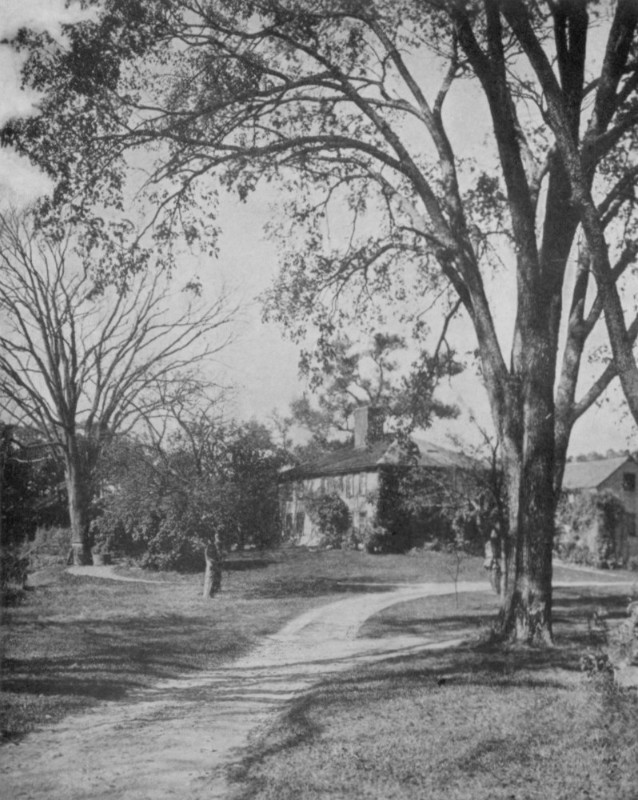 THE GARFIELD HOMESTEAD - LINCOLN 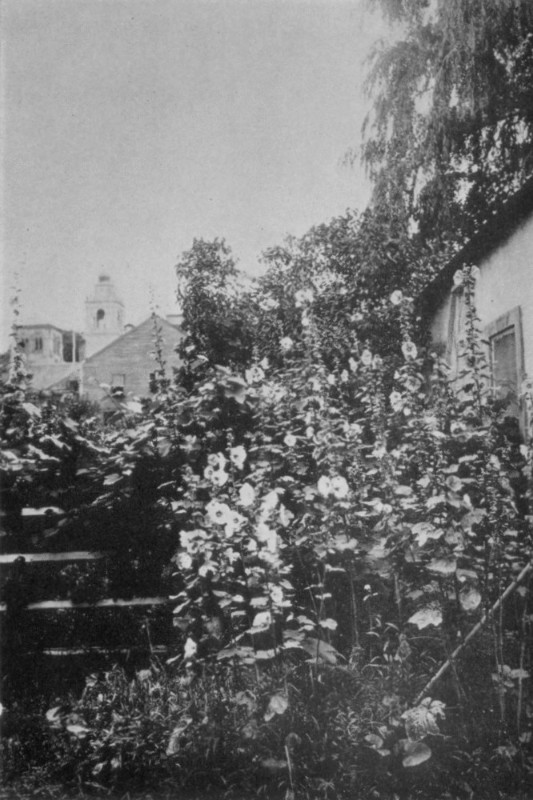 A NOOK IN PLYMOUTH There is an
inspirational effect in touring Massachusetts because back of its beauty lies
its quaintness, its romance, its ideals and the glory of standing for the first
great experiment in a free and expansible principle of government. People come
from the West and the South and stand, often with uncovered heads, at the
patriotic shrines of this state, feeling that hence sprung those virile,
germinal ideas, which, shot through the entire fabric of national life, make it
mean more than the life of any other nation. It is impossible to separate the
sense of beauty from the sense of the past, giving a halo to every landscape.
Howsoever gloomy the day there is an ancient hidden fire discernible pulsating
through the atmosphere and always a rainbow of hope. For here, if the ideals of
Massachusetts prove immortal, will be an enduring and uplifted human society.
And here, if those ideals must die, how glorious will be their burial place! As
in Holland the flattest landscape and the tamest material surroundings often
thrill us with the memory of the contests of those sturdy people, so here every
old roadside is eloquent with the echoes of ancient marches to liberty and
light and power. We need not
confine ourselves to the historic route of Paul Revere in order to move along
amidst challenges to memory and beckonings to nobler living. On many hundreds
of miles of her beautiful highways there are, here and there, edifices which
embody ennobling events, or granite memorials of a past which never lived as
vitally as now. It is true that some old states seem to have outlived their
history. But are not these instances where there was never a really free
people, as in Egypt and Mesopotamia? Wherever human life has struck the high
and fine note the spirit of the fathers seems never to depart. From the
Acropolis and from the Forum we can never miss the glorious shades that have
stood for something fine and strong and helpful in human nature. Still less
in this dear state of our birth, a state now starting on its fourth century of
civilization, can we ever get away from the history that inspires us. We look
forward to the time, we believe not far distant, when patriotic societies, or
the state itself, shall restore and mark appropriately all those homes or
scenes where bold and far-seeing men have taken advance ground and given to us
new standards of thought and action. 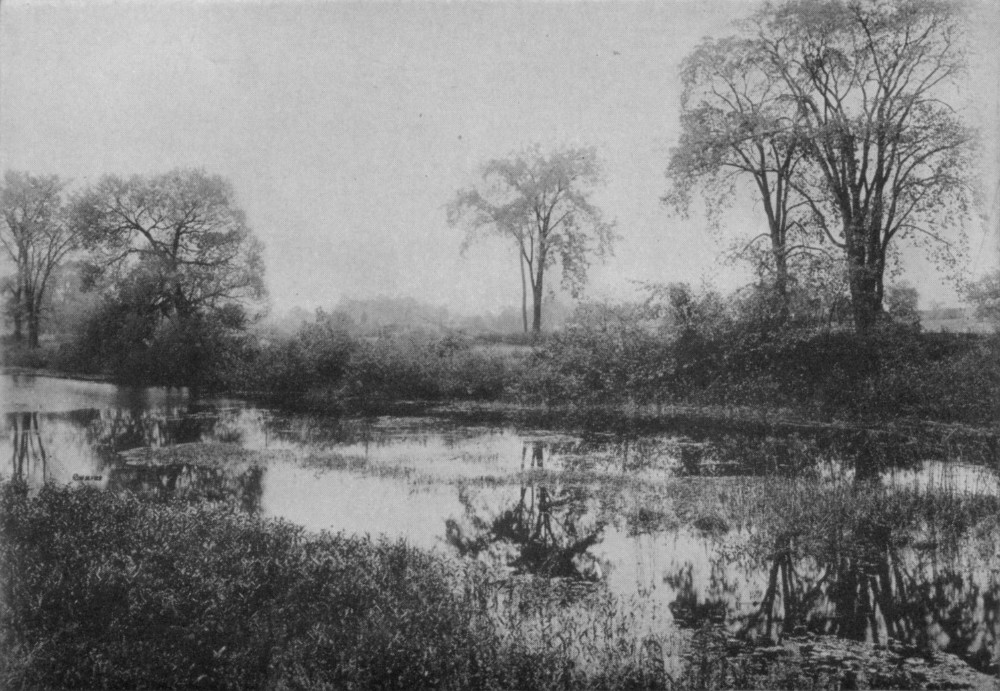 RIVER GROWTHS - HARDING 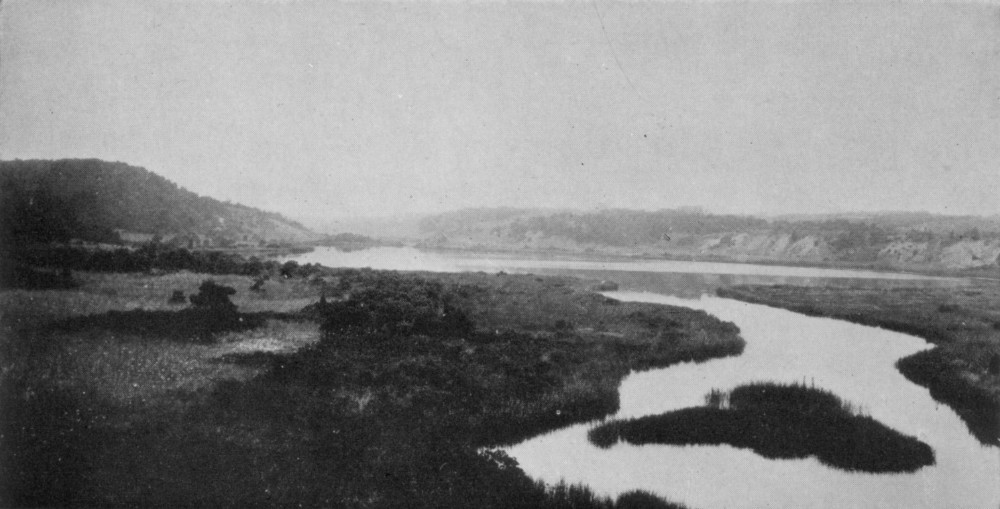 PLEASANT BAY CREEK - ORLEANS 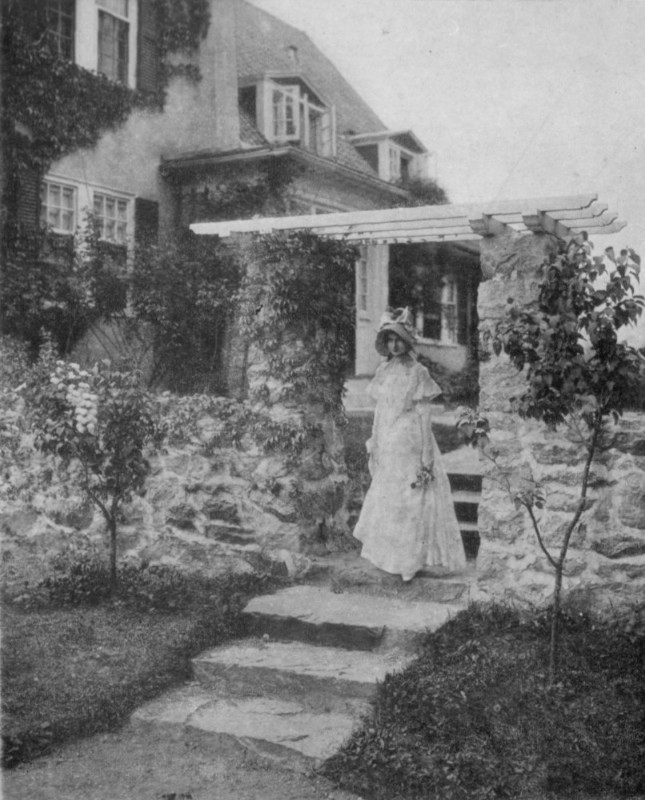 ALL IN A GARDEN FAIR - FRAMINGHAM 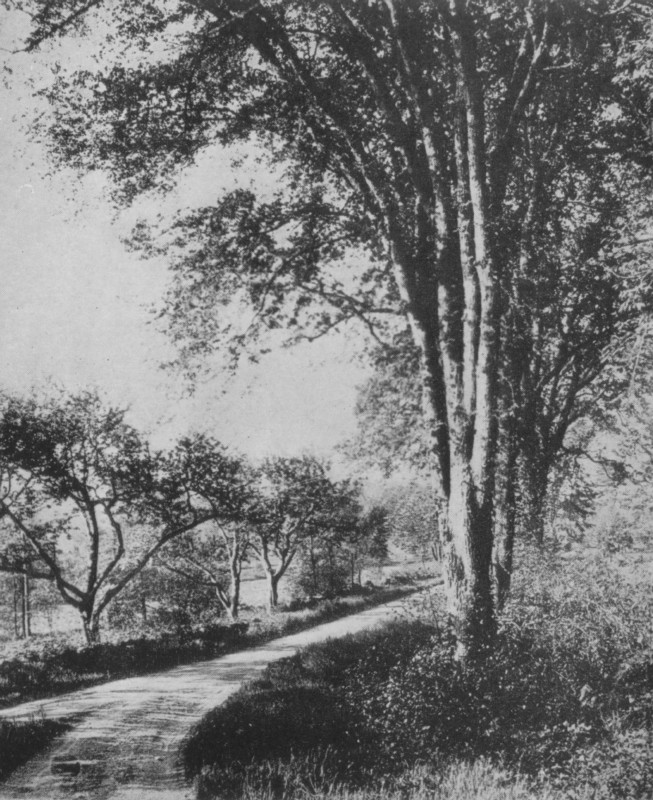 FRAMINGHAM ELM CURVES
THE
residents of Plymouth and vicinity are particular to make it plain to the
traveler that Cape Cod does not begin until we reach the canal. The contour of
Cape Cod and what one sees there are always a surprise to the visitor on his
first journey. These notable aspects of surprise may be mentioned: in the first
place, although Cape Cod is narrow and runs away into the sea, one may journey
the length of the Cape and seldom see the ocean. In part this is owing to the
necessity of keeping a through route away from the inlets in order to secure a
reasonable directness; in part it is due to the hills; but in part it seems a
mystery. The second
surprise awaiting the strange visitor lies in the extremely hilly nature of the
Cape. We are almost ready to say that it is the hilliest part of Massachusetts.
This notably uneven contour adds much to the charm of the Cape, which one would
otherwise find monotonous, Of course the hills being no more than huge dunes
are the effect of wind and sea, but some of them have great height. One would
hardly suppose the elements were so powerful as to create such a contour. But
it is well known that since the settlement of Massachusetts small estuaries
which enabled one to sail through a canal across the narrow portion of the Cape
have silted up. Again, at Chatham the great bluff has been eaten into by the
fierce seas so that within our life-time lighthouses have been removed to safer
foundations. This is stranger inasmuch as many shoals off the eastern part of
the Cape would seem to compel the sea to tame its wrath. We remember with a
shudder even now that the Mayflower came near foundering in the unknown
shallows east of the Cape in her effort to round it and reach "Virginia."
The captain put back because he felt that his position was altogether too
hazardous, and therefore Provincetown became the first landing place. The third
surprising feature of the Cape is its numerous and large fresh water ponds.
These ponds nestling at the foot of sharp dunes are objects of great beauty,
especially as the pond lily, either by nature or cultivation, often spreads its
beauty in their coves. Some of these ponds are of great size; some are divided
from the sea by a mere low sand dike. The water is generally delicious and
pure. In this particular Cape Cod is only exceeded by the region around
Plymouth. It is
useless to follow Thoreau after his classical description of a journey to Cape
Cod. There are, however, many who challenge various conclusions of his and the
native does not regard him at all with favor. Probably the most striking phrase
in his volume is that in which he says that the Cape Codder ploughs the ocean
and his plough is moved by a white sail. It is
eminently true that whatever prosperity the Cape used to enjoy arose from the
wealth of the sea and the industries which were allied with fisheries and
commerce. An
agreeable sleepiness which we trust may not be disturbed pervades some of the
old villages, though these same villages would probably resent being thought
somnolent. Their somnolence is their charm because the traveler does or should
seek rest, and there is a fine aroma about a quiet old village by the sea not
comparable to or equalled by other haunts. Aroma as here used refers to the
spiritual essence and not to the fishy odors which we do not otherwise mention,
but we could, oh, we could! Provincetown
itself has of late, indeed, been seized by a new band of Pilgrims, the
Portuguese who succeeded the Yankee in the fisheries, and who now themselves
are finding other lines of effort more attractive. One finds himself as much in
a foreign land, as is possible here in America, in Provincetown, in spite of
the lofty monument which commemorates the first landing of our fathers. The finest
attractions connected with Provincetown are her back yards, her sea gardens as
one may say, where the rollicking hollyhocks hold undisputed sway, towering
over their humbler floral neighbors. There are little lanes and alleys and
nooks loved by the artist and sought out by the tourist where the flowers,
seeming to get a permanence of beauty by the seaside, are allowed full scope.
It has probably been remarked a great many times that the near influence of the
sea is very favorable to floral development, giving it a brightness and a
longevity of blossom quite superior to that of flowers grown in the interior.
This effect is seen all along as one comes down from Boston. There is
something good to be said for the Portuguese which is not so marked in the
natives of Cape Cod. These natives are quiet and reserved, following the more
usual habit of the English people. The Portuguese are rather notably courteous
and lively and have added a note of joyousness and vivacity which may be more
superficial than the sturdy graces of the English character, but is,
nevertheless, agreeable as met by the traveler. The fine
summer air of the forearm of the Cape affords an escape from the severe heats
of the interior which is scarcely inferior to the same relief afforded by
Nantucket. The land is here so narrow that the climate is essentially insular
and free from the extremes which are so trying in America. It has become a chronic habit to joke about the barren soil of the Cape; to say that it is so poor that one cannot raise an umbrella on it, and to indulge in all sorts of jibing or contemptuous remarks regarding its sands. It is found, however, that certain flowers and produce if well fed by artificial means come to a fine maturity and flavor on the Cape. There are also streaks here and there on the lower lands of fair loam which can hardly be surpassed for many sorts of cultivation. Thus, though the dominant feature may be sand, there is, what with the use of the sandy sites for summer cottages, and the use of the better soil for crops, no small opportunity for much larger development on the Cape than has hitherto existed. 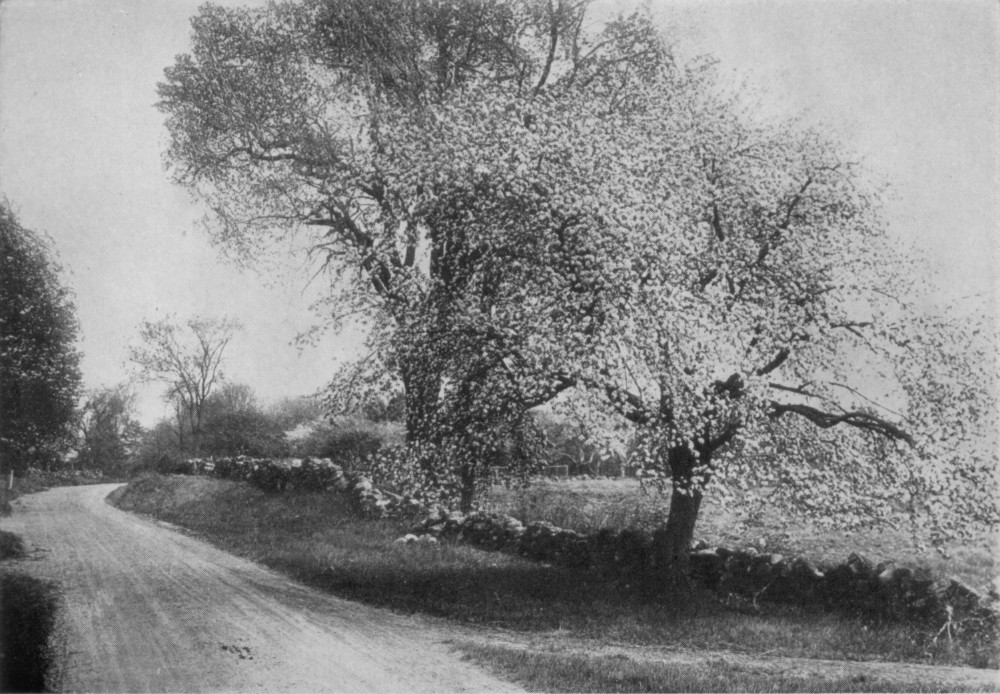 AN APPLE-ELM CURVE - HARVARD 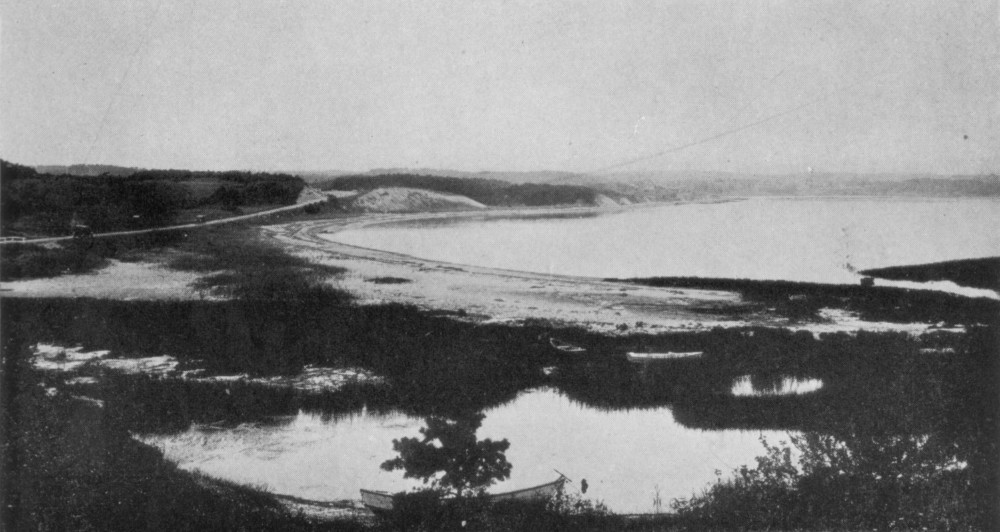 PLEASANT BAY - ORLEANS [ 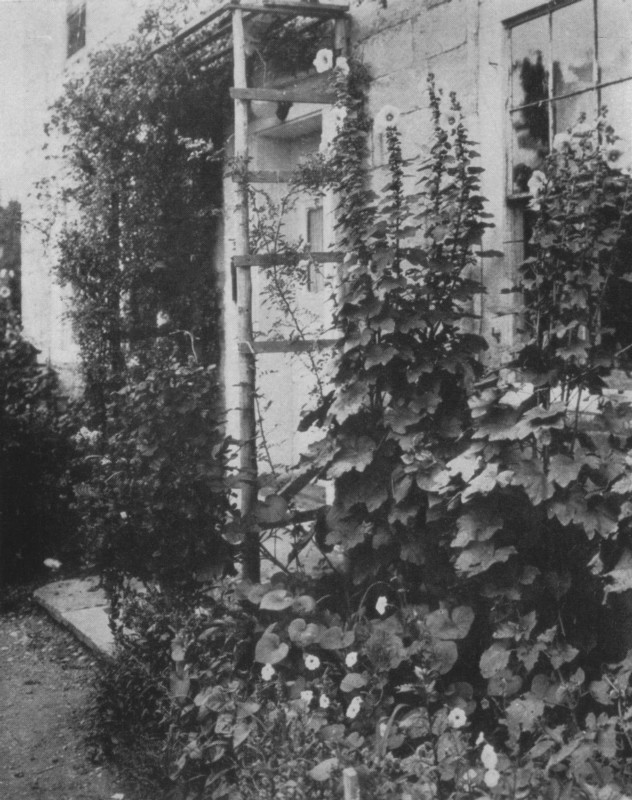 A WEYMOUTH HOLLYHOCK DOOR 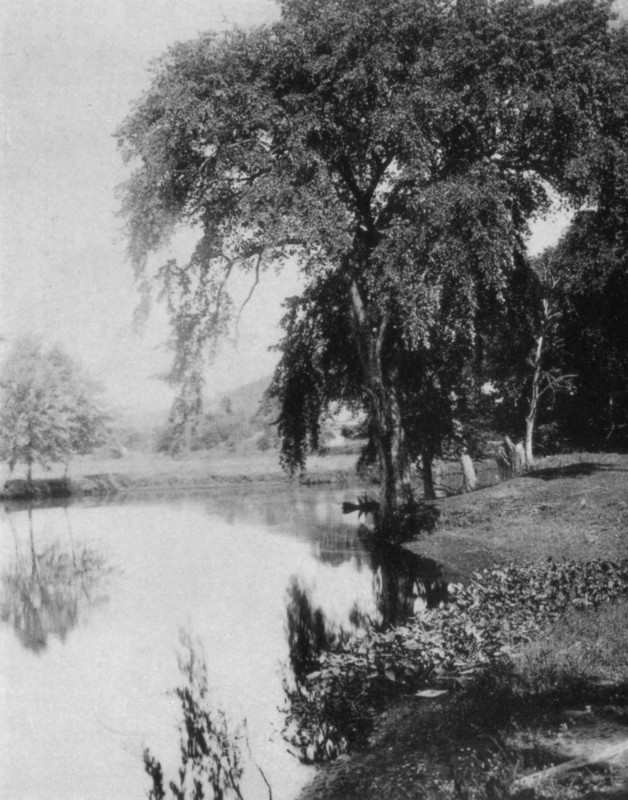 A BELCHERTOWN MARGIN THE POOL AT SANDWHICH, CAPE COD Some
portions of the Cape have gone backward and that to a very great extent, there
being a lonely aspect to certain of the districts which formerly harbored a
considerable number of bold fishermen, nor is this to be regretted. On the
other hand a great many sections of the Cape have developed to an extent far
beyond anything in their previous history. The Cape stands out as the only
readily accessible portion of our shores where summer mildness is obtainable.
It has been said with probable truth that had not the winter of the Pilgrims'
landing been mild the entire enterprise connected with the Mayflower would have
perished and with it the fine moral stimulus which they, in the course of
Providence, imparted to our continent. Provincetown
was the point whence they explored southerly, and they found even then that the
Indians, who from the crudeness of their civilization were obliged to take advantage
of every superficial source of supply, had their scattered habitations on this
portion of the Cape. Provincetown is a delightful sail from Boston and like all
termini has a certain emphatic effect upon the traveler's memory. It is an
agreeable prowling place for those sated with the usual. Moving
southward along the forearm of the Cape one finds in the rolling hills of Truro
a certain romantic lift and stimulus to dream of the strenuous past. Off this
shore innumerable wrecks have brought to an end many a career and have tossed
up, still clinging to life, many a denizen of other regions to take up, in this
precarious manner, his new career in America. Now that
the Cape Cod canal is in operation, coastwise shipping no longer has an
incentive to hug the shoals of the Cape and we may hope, what with the
lighthouses and the experiences of the past, that generations to come will
escape the fearful wrecks which are the most dominant thought in one's mind as
he wanders along these treacherous shores. 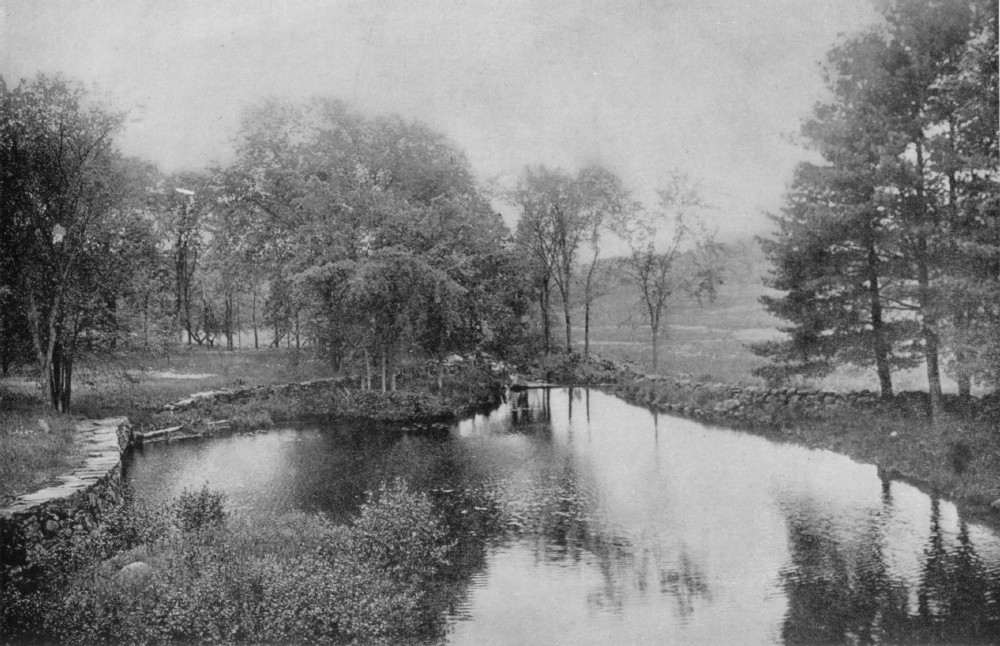 A BARRE BROOK 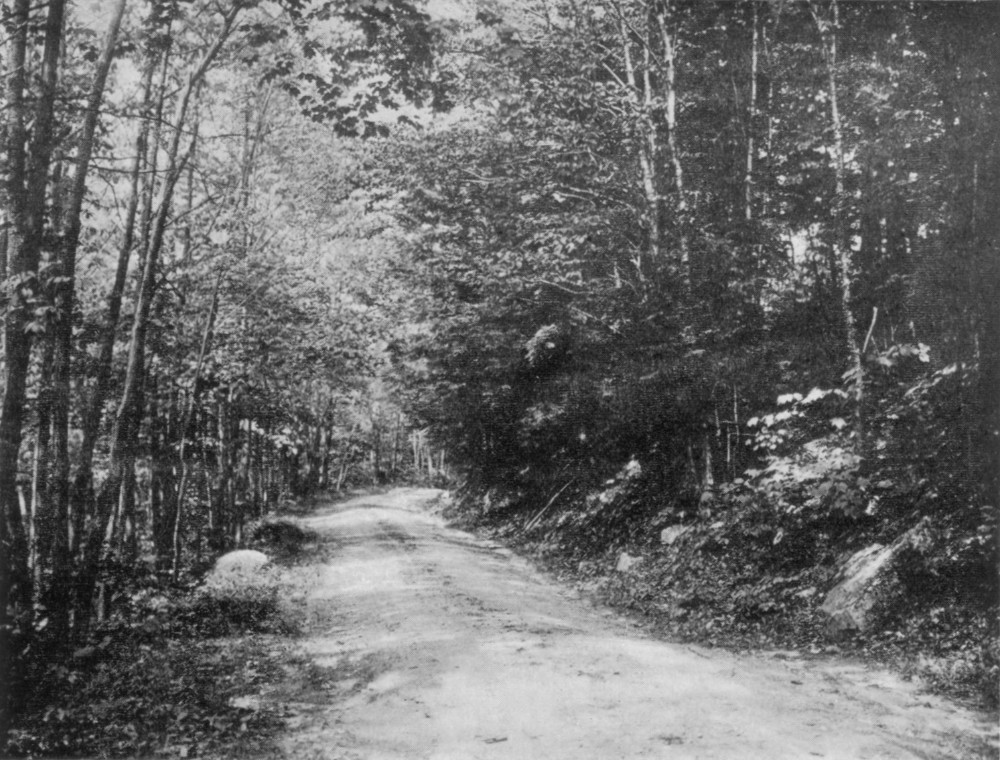 A PETERSHAM WOODLAND 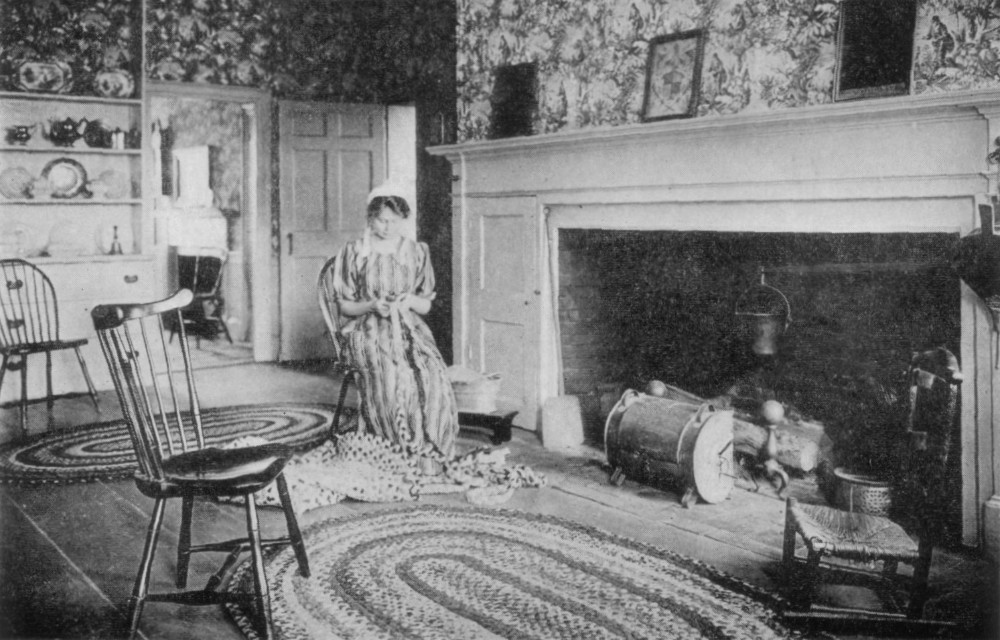 AN OLD DANVERS HOME ROOM CAPE COD COTTAGES
THE Cape
Cod cottage has achieved the distinction of receiving this specific name. There
are many thousands of houses of precisely the same type scattered through New
England but this cottage is so uniformly found at the Cape that we take no issue
with the appellation. The stranger at Cape Cod is often puzzled by the term
"double house." In the Cape Cod significance this phrase refers to a
house with a chimney in the middle and a room on both sides. Frequently the
space on either side of the chimney is divided into more than one room. Of
course, the term "double house" used elsewhere of a dwelling for two
families, confuses the stranger. The name arose on Cape Cod from the fact that
the first settler built a tiny house with the chimney at one end and with
perhaps a front and rear room downstairs, the rear room being a small bedroom
opening off the kitchen. This is called a "single house." The
addition of a duplication of the structure on the other side of the chimney
gives the local significance of the "double house." These
dwellings are uniformly of one story in height although they are often
erroneously called one and a half stories, as they have, generally, two rooms
in the attic. The eaves, however, rise directly above the first floor, as a rule,
without any side wall on the second story. Further, these houses are almost
always shingled. Where they are left unpainted, as is usually the case, they
acquire a beautiful gray which cannot be distinguished from the stone walls
found before one reaches the Cape where such houses also appear. This gray
effect is the result of intimacy with the weather and requires some years to
reach its perfection. In many instances white paint has been applied to these
houses and never with aesthetic advantage. The dweller within the cottage may
indeed protect his dwelling and feel that he has a trimmer anchorage with a
painted house, but he loses that mellow melting into the atmosphere, and that
nameless charm of roof and side wall in the same natural tint. No possible
preparation of the shingle can give an artificial color matching this superb
gray. Furthermore, the side wall of a house will last for generations without
paint. The "John Alden" house at Duxbury has some of the original
side shingles applied about 1663. It is true they are getting to need some
repairs! Of course the old shingles were often made of shaved pine which render
them almost eternal. The sawed shingle catches and holds the water whereas the
shaved shingle sheds it. There is a
remarkable absence of gambrel roofs on Cape Cod, The author was informed that
there were none whatever on the Cape. It was with some glee, therefore, that he
discovered a very ancient gambrel roof in Chatham, but he admits that it is the
only one that he has seen. The usual
Cape Cod cottage is very simple but has a winning quality. Persons of wealth
sometimes construct such cottages. If they are erected so that two or even
three cottages meet each other by a lap wide enough for a door, the effect is
very excellent and one has the advantage of all possible light and air. In such
a case the attic may be left in the rough and soon becomes the receptacle of
all sorts of useless but delightful lumber. The Cape
Cod cottage at its best should have a large chimney. Unfortunately the
reasonless craze for improvement has resulted in the destruction of such
chimneys in many instances and the erection of shabby, spindling affairs under
the alleged excuse of getting more room within the cottage. Of course this
means the abolition of the old fireplaces. Even if a new chimney is erected
there is no reason for drawing it down to so minute a dimension since to do so
takes away all dignity from the house. We cannot enough deplore the hateful and
tasteless arrangement of a wooden frame work around some chimneys in recent
construction to give the effect of size. This work is false to art, to taste,
to sentiment and to reason. These old
chimneys sometimes have a rounded top to keep out the weather as is the case
with one shown in this book. More often, however, they were left so that the
storm might beat in. This fault may be overcome by placing a stone set up at
the corners over the chimney so as to permit egress of smoke if one does not
care to take the trouble to construct the arch. The Cape
Cod house is further characterized in its best form by three minute windows on
each end in the gable, one on each side under the eaves lighting the long
closets in the otherwise useless space divided off from the attic room, and the
third at the point of the gable, ventilating the dead air space over the attic
room. These little windows, invariably with four lights of glass, are sometimes
called "dog house windows." A lady of
our acquaintance in trying to recall the name referred to them as "little
dog windows." 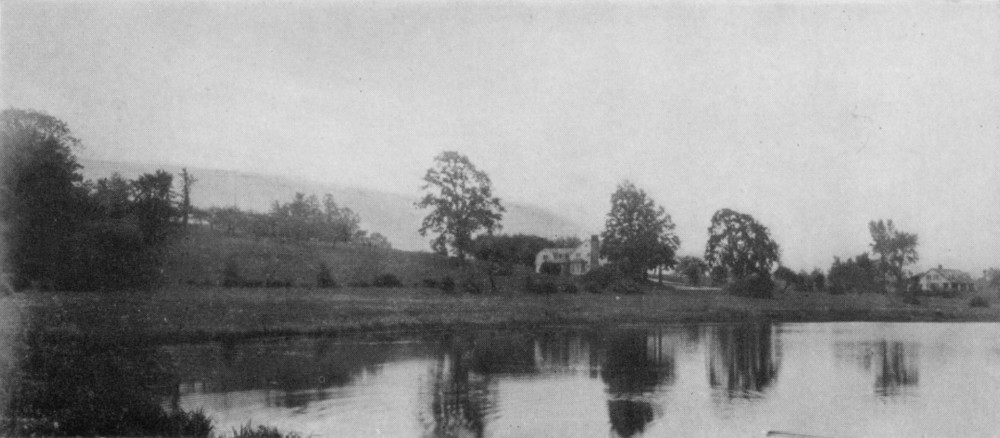 STOCKBRIDGE 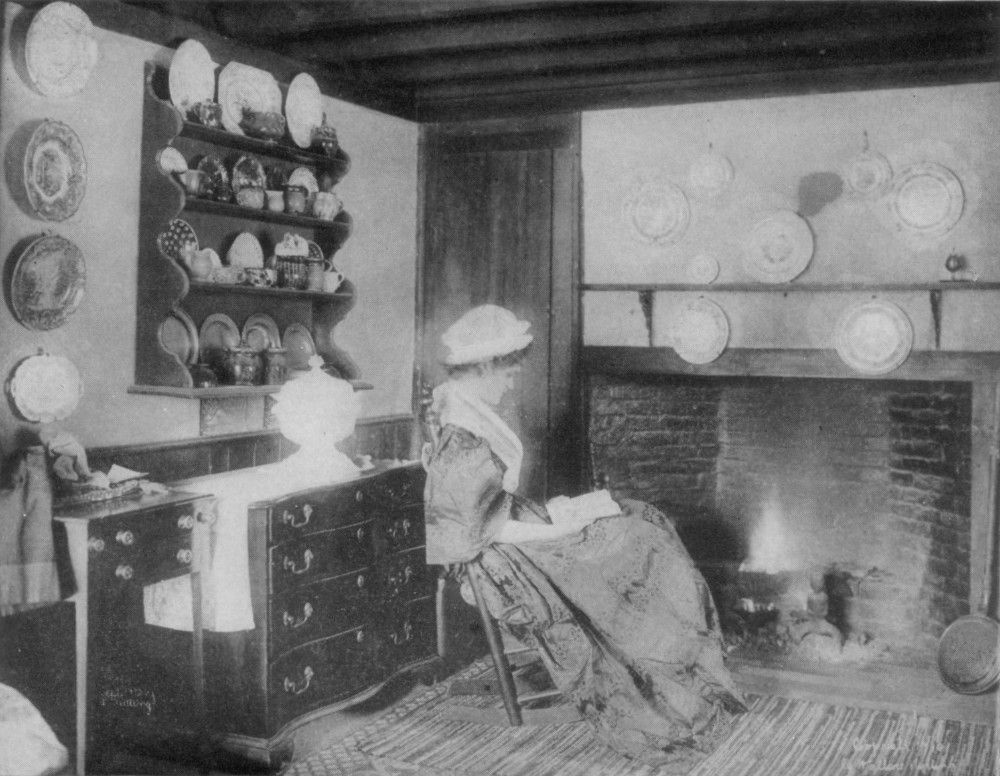 A CORNER IN CHINA - NANTUCKET 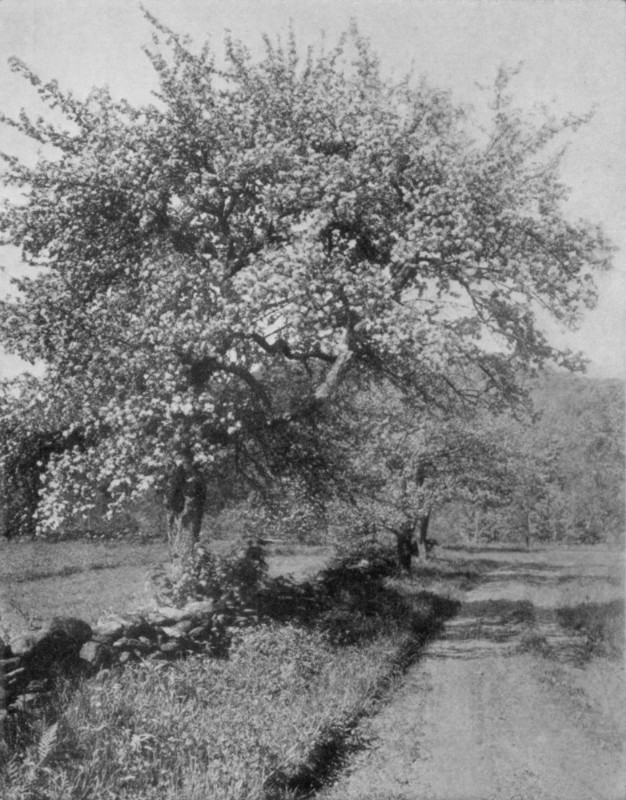 QUEEN OF MAY - ASHFIELD 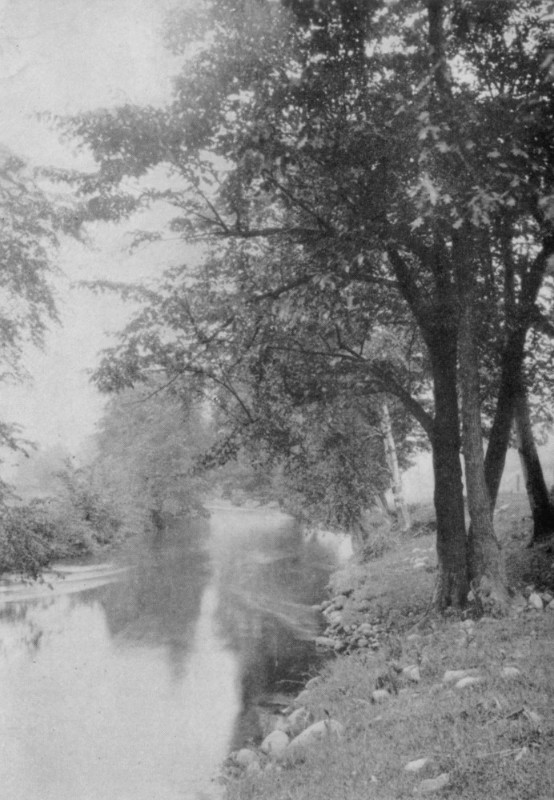 ADAMS In rare
instances, the excellent architectural feature of a slight overhang on a line
with the eaves, on the gable end, gives the house a great deal of added beauty
and dignity. The front doors of these houses do not have head room permitting
an elliptic light but semi-occasionally there is a line of low transom sash. In
the best examples of earlier houses the window frames are well set out, being
constructed of solid sizeable joists pinned together and enhancing the good
lines of the dwelling. Within, of
course, there is a substantial fireplace on each side of the chimney in the
double house, which greatly preponderates. In the rear there is sometimes a
lean-to, although there is very little room to run a roof down, as the eave
line is already low. In any case, however, there is sometimes in the rear a
small kitchen and a third fireplace on that side of the chimney. The front
door opens into a small square entry formerly called the porch, and there is a
narrow, steep stair running sidewise across the face of the chimney. A cottage
such as we have described, if it still has a stone wall or a post and rail
fence about it, or even a picket fence, a few shade trees, and if it stands
back somewhat from the street, is a very good example of the sort of home which
meets all human need and possibly may be looked forward to as a future
possession of every family, even the poorest. Meantime, it appeals to persons
of the best taste as a desirable summer residence and by its unpretentious
merits and simple beauty is in a way to teach us the quiet life. Occasionally
in the larger towns of the Cape, especially as one gets back toward the
shoulder of the arm, we see the conventional two story house. Some of these are
of a very excellent type, as in Brewster, Yarmouth and Sandwich. Such a house
shows adjoining the church across the pool in the little sketch called
"The Pond at Sandwich." For those
who are somewhat ambitious or are so thoroughly wonted to a sizeable house as
not to be satisfied with the Cape Cod cottage, these last mentioned towns and
others, as Hyannis and Falmouth, offer very attractive residences even for the
whole year. The snows upon the Cape are not so deep as are found inland and
winter motoring is less often interfered with. There is, to be sure, more wind
even in this quarter of the Cape than farther inland, but compensating
advantages are found. VEGETATION
ON THE CAPE THE trees
of the Cape as we first enter it from the west are in many cases noble elms
shading the villages with dignity and spreading arching beauty. As we journey
eastward the elms become very rare and the characteristic shade tree of the
Cape is the poplar. We seldom see such noble poplars as seem to flourish here.
It is very common to see rows of them before cottages. Evidently the soil is
well adapted to their growth. Another tree unusual elsewhere is called the Tree
of Heaven. It is uncommon even on the Cape. If you look at a blue china plate
of the common willow ware you see this tree reaching over the waters where the
runaway couple is hastening across. The foliation and the small branches remind
one somewhat of the locust. At first glance it is often mistaken for that tree.
It is probable that seedlings were brought from China by some of the old
captains. The possession of such a tree, especially if of dignified size, gives
a Cape Cod cottage a singular distinction. The
prevailing winds have governed all trees well out on the Cape, and they slant
to leeward. This is the more remarkable as there are, it is to be presumed,
prevailing winds far inland but this effect is seldom seen except on the
shores. There is little need to call particular attention to other vegetation on the Cape perhaps more than elsewhere except as relates to the small fruits already hinted at. On one occasion as we wound along a by-road we came upon a neat cottage worthy of portrayal. As we skirted about it we discovered the most luscious and wonderful cultivated blackberries we have ever seen. They were at the acme of perfection and we look back to the hour as that in which we exhibited a marked degree of Christian fortitude. With mouths watering and fingers itching, with no one looking, and even the cottage locked and everyone absent, was it not a mark of a deep-down religion which prevented our even tasting? How we wanted to try those berries! "'Twere worth ten years of peaceful life one quart of their array!" But we didn't, we didn't! But whether as much character would assert itself in us again we are entirely uncertain. 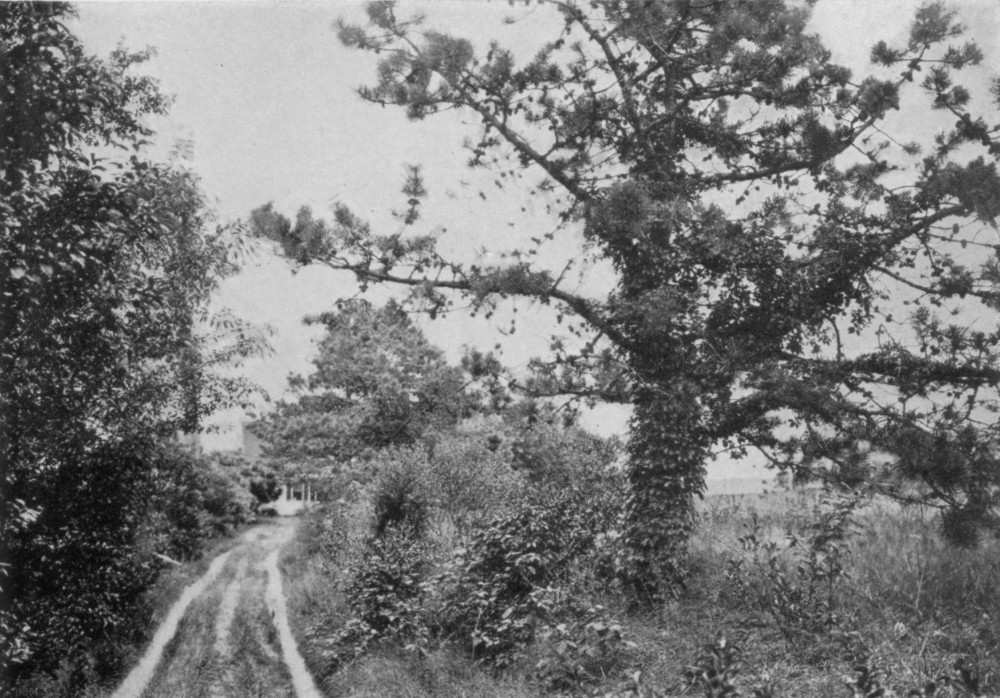 A DECORATED PINE - DUXBURY 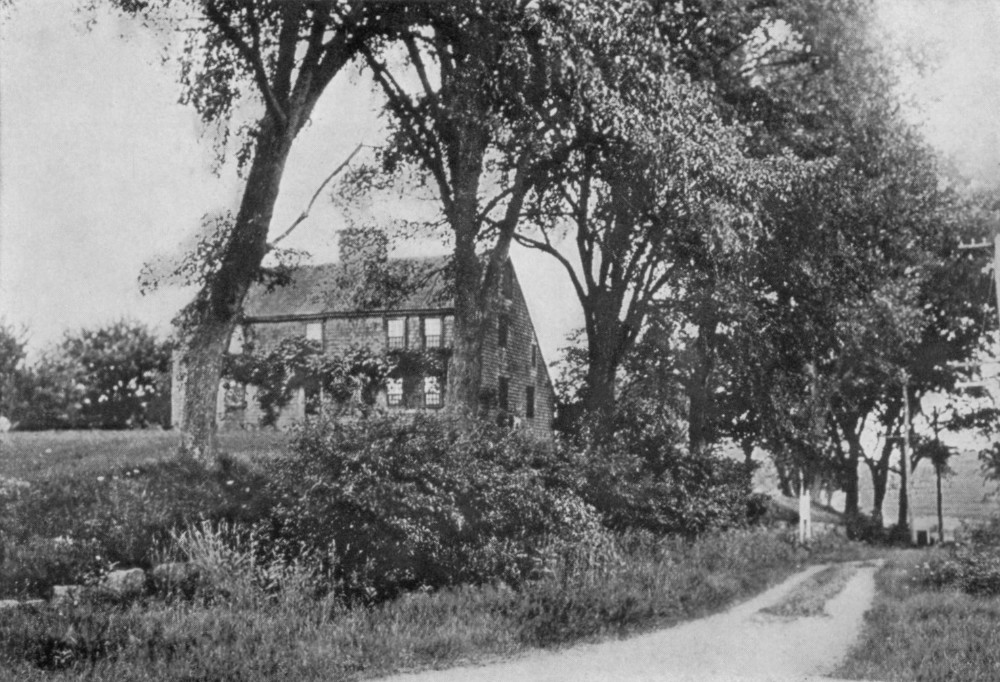 THE MAJOR BRADFORD HOUSE - JONES RIVER  A HYANNIS BYWAY 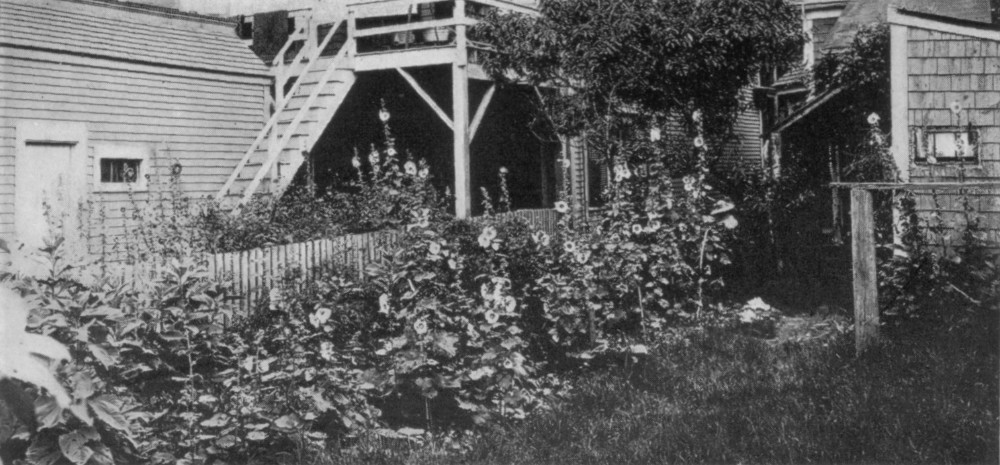 A PROVINCETOWN BACK YARD BROADWAY, NANTUCKET The
vegetation of the Cape is not particularly early. The sea holds back the spring
just as it holds off the autumn and tends to equalize the seasons but the
fruits and flowers are wonderfully attractive. Of late, also, certain areas are
being exploited commercially with rye. The water
growths of the Cape are strikingly attractive. All about the margins of salt
lagoons there are lovely grasses, and by the brook sides and wherever lowlands
encourage water to lie, the tall reeds with their blossoms or their cattails,
according to the season, form artistic borders. By a cottage near a brook where
children played as seen on these pages we lingered with them by the hour. The
clear sand, the luscious high swaying reeds, the near-by cottage door where the
housewife sang, the mellow sunlight and the little bridge by the side of which
a turn-out for watering horses ran down across the brook, — all this held us
and gave us back our childhood. Doubtless
botanists revel in the flora of the region, for to us laymen the general effect
has no less charm, though we are unable to name all the varieties that decorate
the scene. Various
narrow and sometimes modern roads meander across the Cape here and there and to
us they are fully more attractive than the main thoroughfare. It is here, too,
that we find the gnarled pines surrounded by carpets of needles and graced by
innumerable little cones. Such an one on a private by-road is shown whose
artistry is enhanced by a clinging vine. THE BAYS
AND SHORES OF THE CAPE WELLFLEET
has its estuary which at full tide, bordered as it is with waving sea grasses,
is most appealing. Farther out through the town we come upon a hostelry, built
on a dock. Americans are not nowadays, at least, a sea-faring people, nor do
they love the sea, nor do they love the water like the British people. We have
noted here and there inland, or on the seashore, boathouses and every
preparation for water journeys, but many an instance we know where from year to
year the boathouse is not opened and many other instances where it is opened
but once or twice. The English seem natural water dogs, and they go boating not
as a fad, but because they cannot resist the temptation. One can but note how
few and far between are the American coast points where boating is much
indulged in. Before the days of railroads it was otherwise. Now the entire
flavor of the shore life is being lost so far as playing or laboring with
watercraft is concerned. Even at the bathing beaches it has become a joke that
the fair bather spends her time upon the sands and seldom wets her feet. The
delight of battling with the water seems to have been lost out of the American
temperament, with here and there an exception which proves the statement. 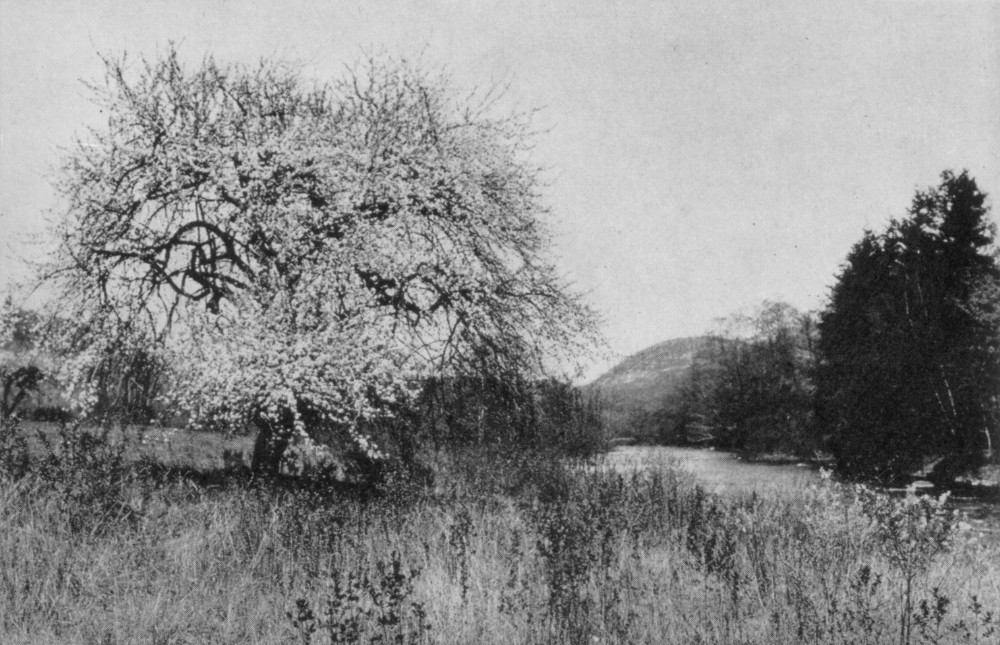 BLOSSOMS AND GRASSES - ERVING 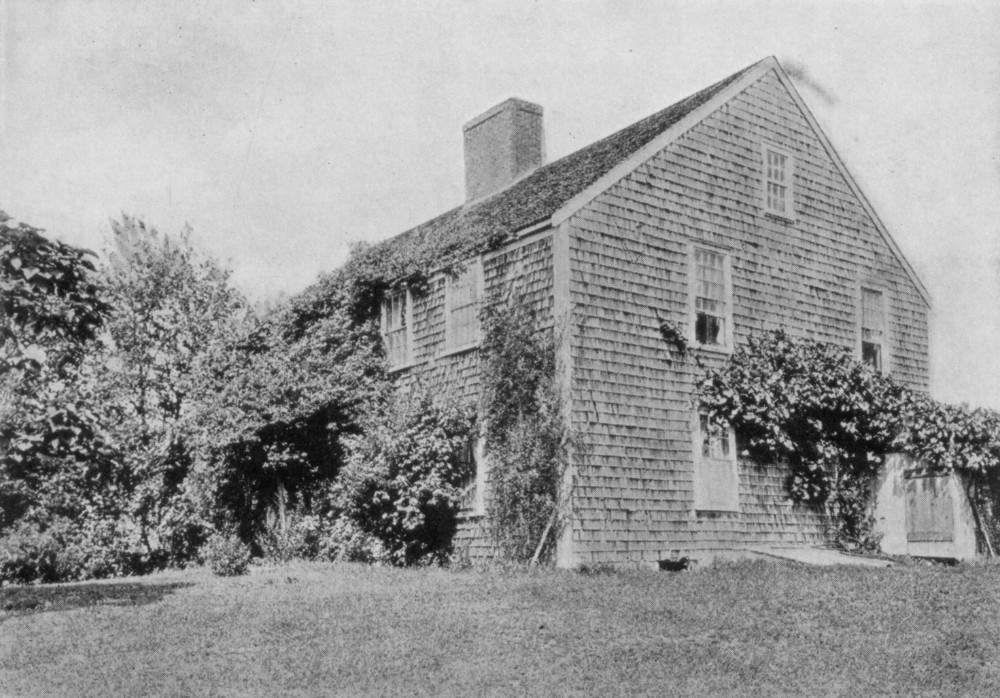 THE JOHN ALDEN HOUSE - DUXBURY  WELLFLEET ESTUARY 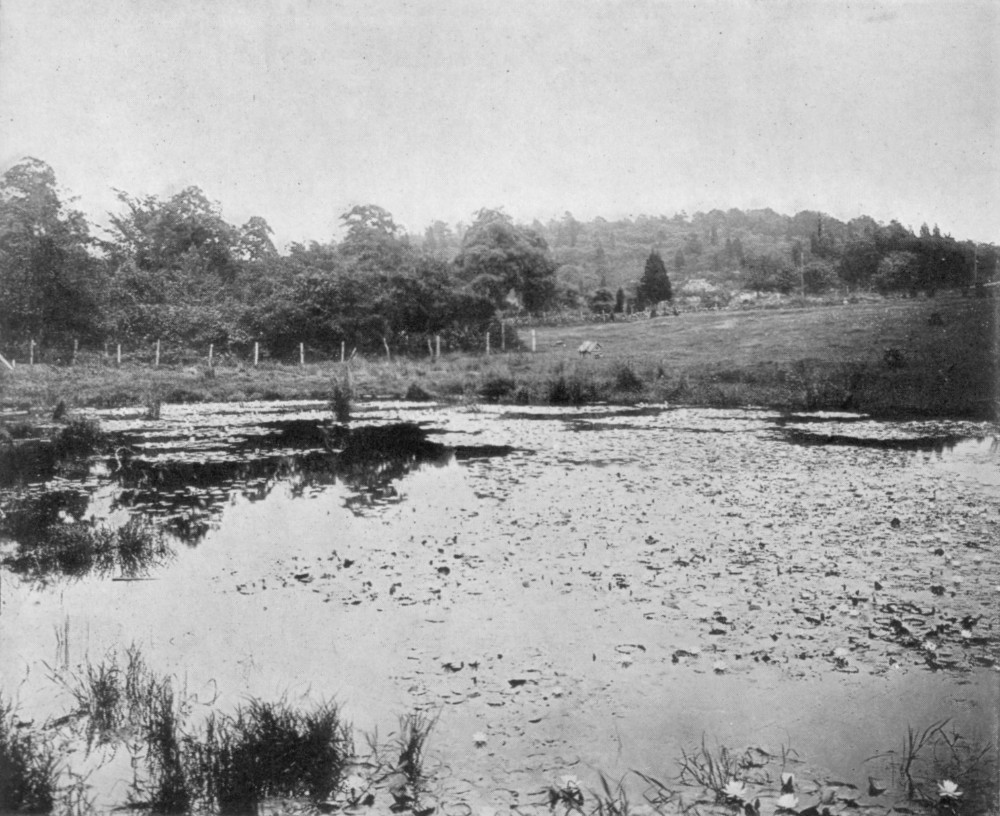 FALMOUTH LILIES The harbor
at Wellfleet is one of the few of considerable extent on Cape Cod and at one
time the district was a center for whalers. Provincetown appears busier on the
water than other Cape regions except possibly one or two of the larger centers
near Hyannis and Falmouth. The artist
on the Cape may find much inspiration in the long tongues of shallow water that
creep through the lagoons and wind serpent-like in the marshes. About Orleans,
on Pleasant Bay, and on the road to Chatham there are wonderful curving shores
and tufts of marsh grass and dune reflections that enable one to become lost in
the spectacle and linger long in the late afternoon and into the afterglow,
heedless of the call of hotel repasts. As a summer
site what can exceed in beauty some high dune looking over the shimmering sea
which plays in and out with indefinable contour lines along the sands? Here and
there appear a winding bit of road, a clump of hardy pines, a cluster of
poplars. Above there is today a flock of the sheep of the sky feeding on the
azure plains, tomorrow a curdled mass of wide flung clouds, and the next day
the glories of purple, gold, sea-green and the entire gamut of the rainbow
list. Rising, spreading, changing until the chameleon-like clouds assume not
only in color but in form a variety of aspect which must seem to a savage race
as, indeed, it should to us, the play of God with nature! To those
who love change, Cape Cod is infinite in her variety! From summer to summer her
coast line changes. One season she fills up an estuary and opens another far
away. Some say that in time there will he no Cape. Others would say that once
the Cape ran far, far out to sea beyond its present bounds and reached its long
finger toward fabled Atlantis. The Cape stands for the beauty and instability
of the earth. Continuous
dredging, far beyond the commercial warrant for it, would be required to keep
deep water at some small ports where once the arctic whalers rode at ease. Thoreau
describes the Cape in a storm. The usual traveler sees it only when it is on
its good behavior, — when it is putting its best foot, or perhaps we ought to
say its crooked finger forward. Then it can be most alluring. It is the Calypso
of the Massachusetts coast, charming us on to admire her softer and playful
moods and leaving us totally unsuspicious of the fierceness of her wrath, when
facing a boreal blast she waves her ruffled train of sand and howls with the
furies of the storm. Cape Cod is
now an island. There are drives each side of the canal for its entire length
and both are pleasing. 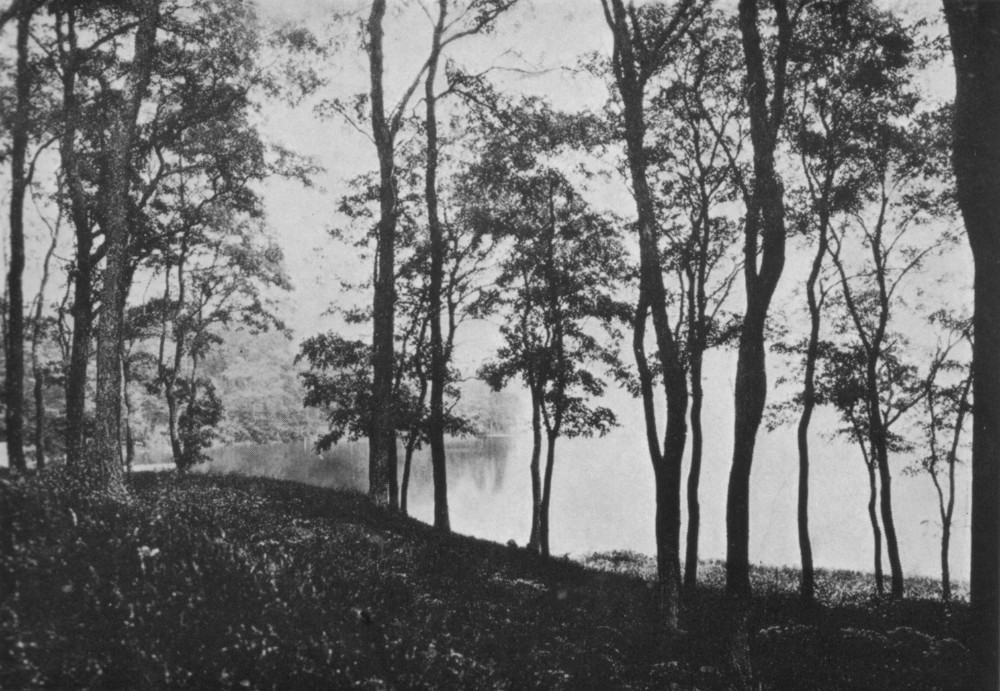 A HAZY WOODLAND - ORLEANS 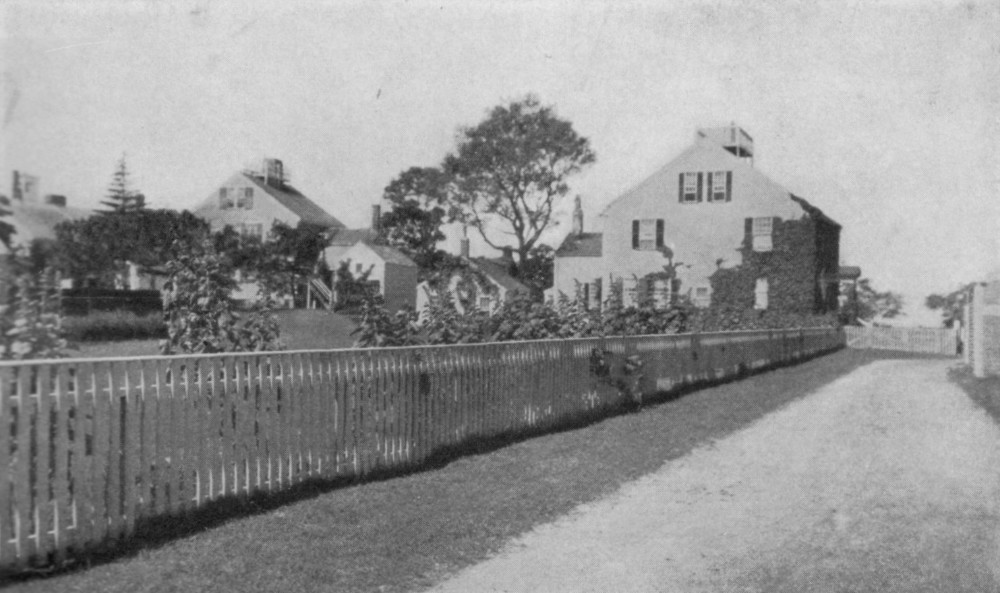 NANTUCKET CHARM 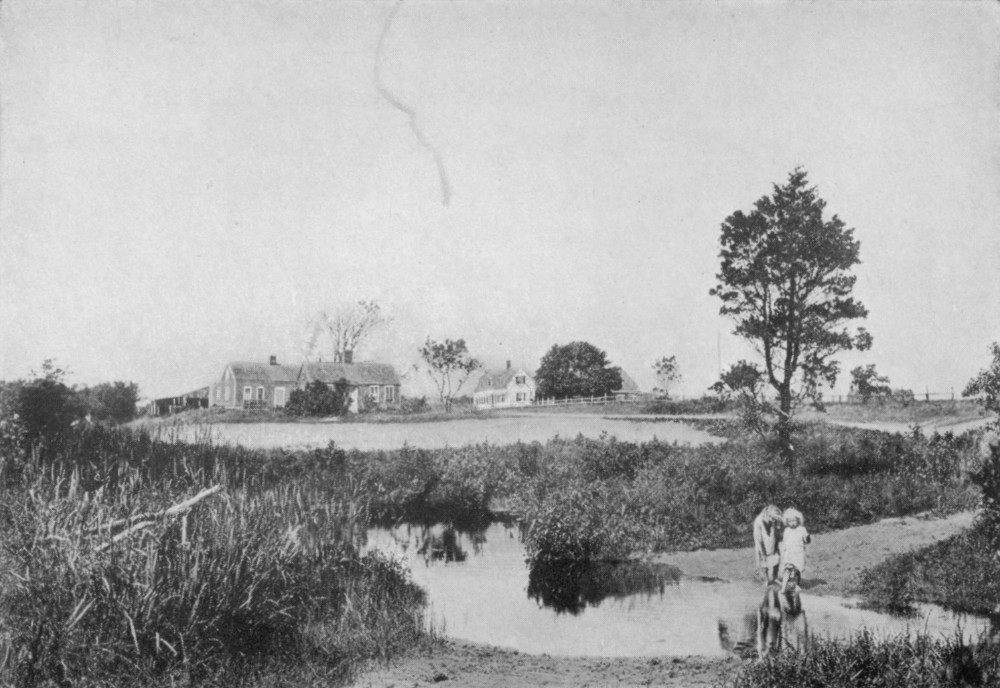 WHERE CHILDREN PLAY - NEAR HYANNIS 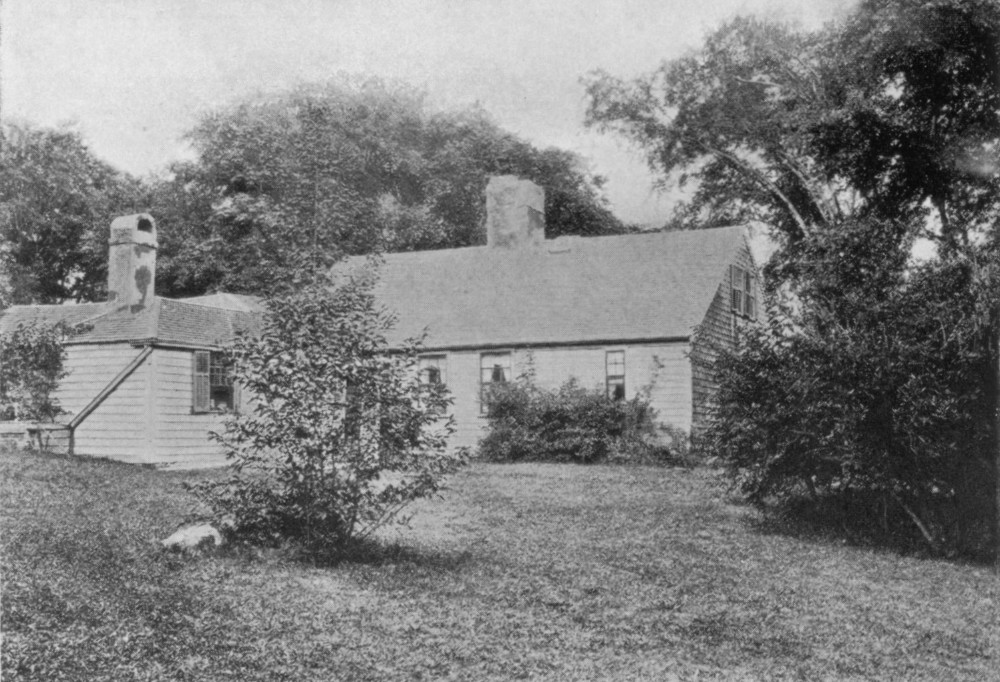 THE THATCHER COTTAGE - YARMOUTHPORT SUMMERING
ON THE CAPE SAD to say,
the Cape is becoming fashionable. The Great War increased the importance of
Chatham as a naval station and all the region of the south shore westward from
Chatham is now being possessed, so far as hotel life is concerned, by Society,
with a very large "S." If this trend continues there will inevitably
follow the construction of many large, modern hotels. At present it is almost
impossible to secure accommodations except one provides far in advance.
Sophistication possesses all the south shore and although here and there many
pleasing summer places, some modest, some pretentious, escape the whirligig and
vapidity of the centers, one finds too much of transported but not transformed
metropolitan life. The shops are branches of the well known city caterers to luxury.
We
ourselves, who are given to the collection of antique furniture and its allied
subjects, find no lack of places where the wise and the foolish congregate
seeking some old heirloom. It is true that one sees perhaps a chair which
leaves him puzzled. It reminds him of the professor in entomology whose
students thought "to put one over on the old man." They took the body
of one bug, the thorax of another, the head of a third, the wings of a fourth
and fifth, the antennae of a sixth and the legs of a seventh and further
decorated the nondescript creature with such odds and ends of insect creation
as pleased their antic fancy. After carefully connecting these incongruous
parts into the semblance of a strange creation they took their bug to the
professor and stood about in a body while they said, "Will you please tell
us the name of this bug?" "Gentlemen," he answered, after a
sardonic glance through his glasses, "I will. It is a humbug." In looking
at this chair those who really know will recognize a pair of front legs that
have known each other long but are unacquainted with the legs behind. The rungs
are recent neighbors who formerly were far apart. The stretcher "knows no
brother." The slats are certainly wondrous between such posts and the seat
is a marvel of oddness. The offerer of this striking piece of furniture, who
possibly himself is merely passing it along from the genius who contrived it,
will, indeed, give you its name called after some of the great masters of old
cabinet work. Nevertheless, my friend, remember what kind of a bug it is! We are not
saying that the dealers in these wares are anything like as unethical as the
farmer who, also by the roadside, displays his baskets of fruit, always with
the fairest on top. This is something which no dealer in antiques would do. Nor
do we intend to hint that the dealer in heirlooms misrepresents one half as
much as the average advertisement of a city emporium. But what would the Cape
Codder do in summer without a resort to such a shop where he may sharpen his
wits against the Parthian, the Mede and the Elamite? And if the deponent saith
true he is against an efficient grindstone, Not for a moment, however, would we
be understood to intimate that the purchase of such articles is any more
dangerous or deceptive than a flirtation with a girl of doll-blue eyes, nor
more dangerous than a speculation in real estate next door to this same shop,
nor more dangerous than motoring on a summer Saturday. Life is so full of its
perils and just now it is fuller than usual. All we do wish to say as to the
aforesaid dealer, is that he is every whit as good and as bad as his neighbor;
that he is not a bit different from folks; and that he has an advantage merely
in this, that the buyer is more ignorant of a good chair than of a good potato
or a good house lot, and therefore is at a disadvantage. Perhaps the largest summer industry of the Cape is the disposal of Victorian antiques, which are very real and honest, as pre-Revolutionary relics. Some of these "came over" and some of them "come it over" us. They probably were not on the first lading of the Mayflower, but please remember she has lately been found to have made various other voyages and who knows what she brought! But with all the strictures that have preceded this sentence we gladly allow that the west end of the Cape has lately brought to light two of the most marvelous pieces of the Seventeenth Century furniture known to antiquarians. It is the spirit that moves the prospector for gold that is also found in the seeker for old treasures on Cape Cod. Mankind are by nature, and often by training, gamblers. They love the thousand to one chance and if they would all stand up to be counted how few of us there are who have not taken that desperate venture! It would be well worth while to spend a summer to run to earth one treasure that the Cape gave up a year ago. The finder lost his chance by being a trifle too canny and to the writer was thus opened his opportunity, Others labored and he entered into their labors. 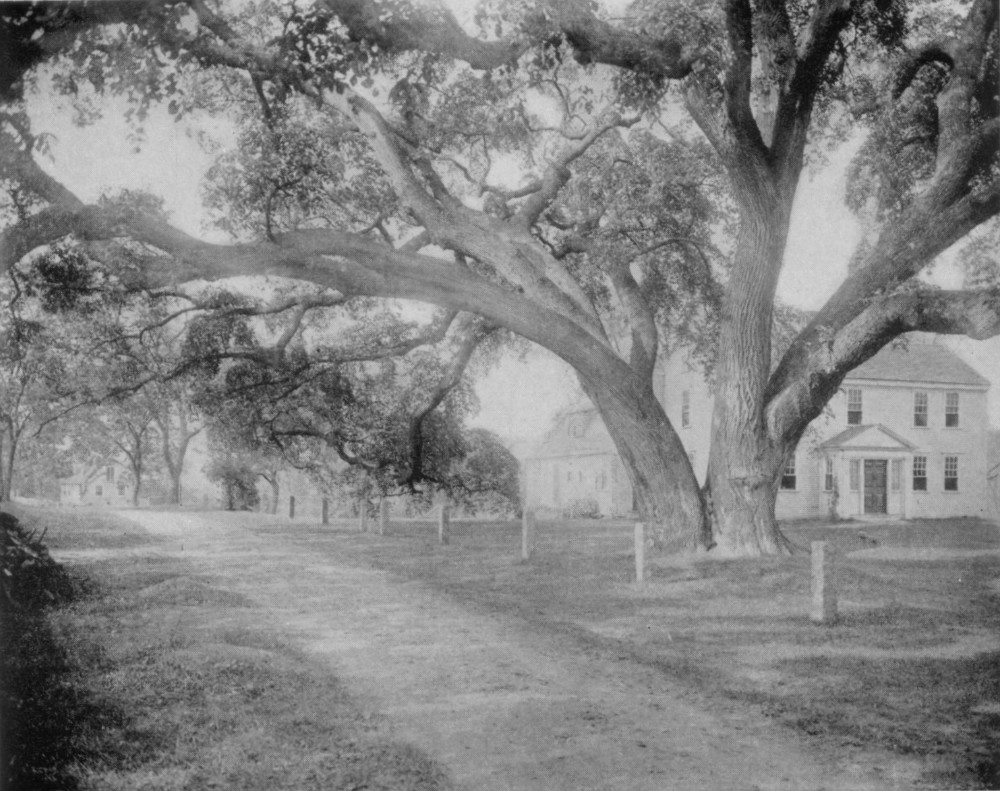 A PROTECTING HOME TREE - FRAMINGHAM 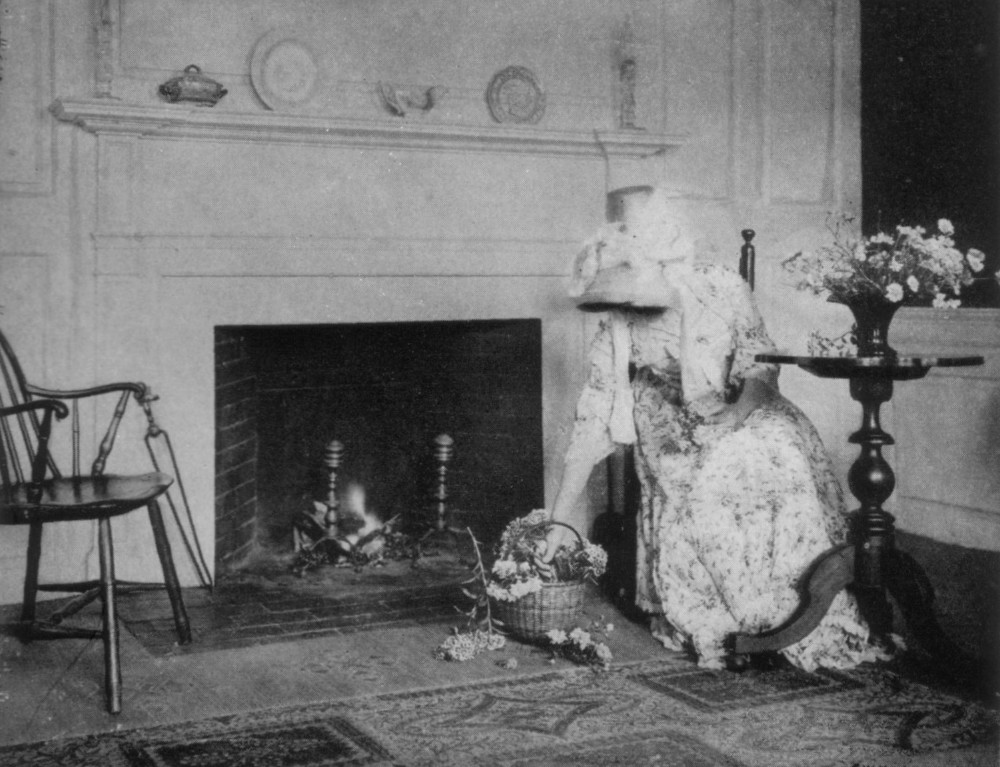 MORNING DUTIES - NANTUCKET 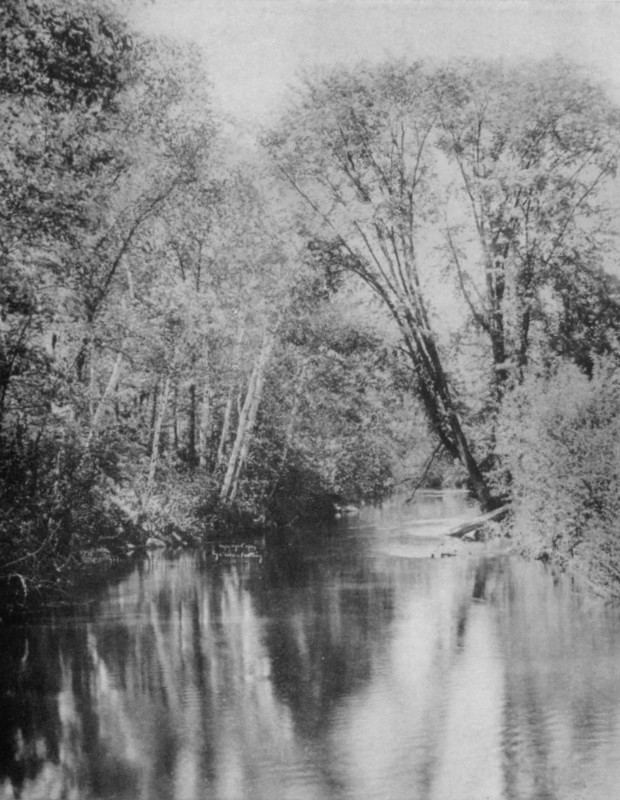 QUINSIGAMOND BIRCHES 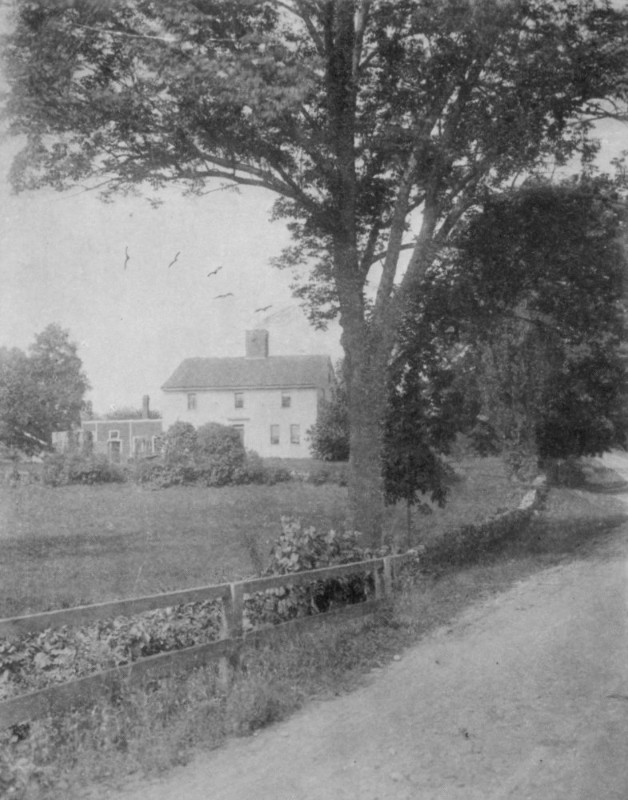 WHITTIER'S HOME, NEAR AMESBURY A VILLAGE MANSION Another
industry of the Cape which may be said to have added to its picturesqueness,
but perhaps not to its calm and beauty, is the innumerable wooden whirligig
toys that ride their wires and poles by the wayside, painted in colors such as
no sunset ever showed. It is little to be wondered at that the windmill figures
largely in these toys because it is so scarce on the Cape. In fact, we think
there is scarcely a region where windmills are more rare. A few, indeed, of
these fine relics abide, and some have been incorporated into homes, and others
are tea houses or show places. The march of improvement and the tooth of decay
have alike contributed to their extinction. To the
average citizen an attractive summer on the Cape is perhaps to be obtained most
easily by the purchase or lease of a Cape Cod cottage from which little
journeys may be made as one lists. If the Cape continues to grow in popularity
it is likely to stand out as the most distinctive of our American summer
resorts. It is even a question of whether it may not surpass Newport. Happily,
fashionable folk no longer look to the exquisite hills of Berkshire County with
the same undivided attention as formerly. The trend to Cape Cod is no less than
a furor, and when all its advantages are considered one can hardly say that it
is too much sought. Ridiculous experiences in stuffy kitchen bedrooms or low
and torrid chambers, or even in barns, are now met by the unwary traveler, not
forewarned of the great demand for accommodations. If Cape Cod
is to sink into the sea and be forgotten, obviously Americans intend to have a
good look at it first. It is an old axiom forgotten every day that we find what
we are looking for. If we look for gimcracks, gimcracks will be produced. If we
want beauty we shall find it, or if we look only at the surface we shall not
see below the surface. Those who come to Massachusetts with the discerning eye
will be filled with the sense of the pathos in her past and will respond to
the. meaning of her efforts, whether or not those efforts have reached full
accomplishment. The spirits and the true hearts of all ages thrill to the same
chords and answer to the same beckonings. The deep without speaks to the deep
within. Whether it is a picture or an ideal it means whatever the largeness of
our nature can grasp. History is "bunk" according to the apostle of
the mechanical age, but those who are making history naturally carry on
faithfully all the great beginnings which the ages have left us. To them Cape
Cod is not a sand bank but an adequate foundation where truth and honor and an
outstretching faith limned forth in the sky a permanent and glorious state in
which human character was to reach a dignity transcending time and space and
capable of making every square foot of the earth prophetic of perfection. 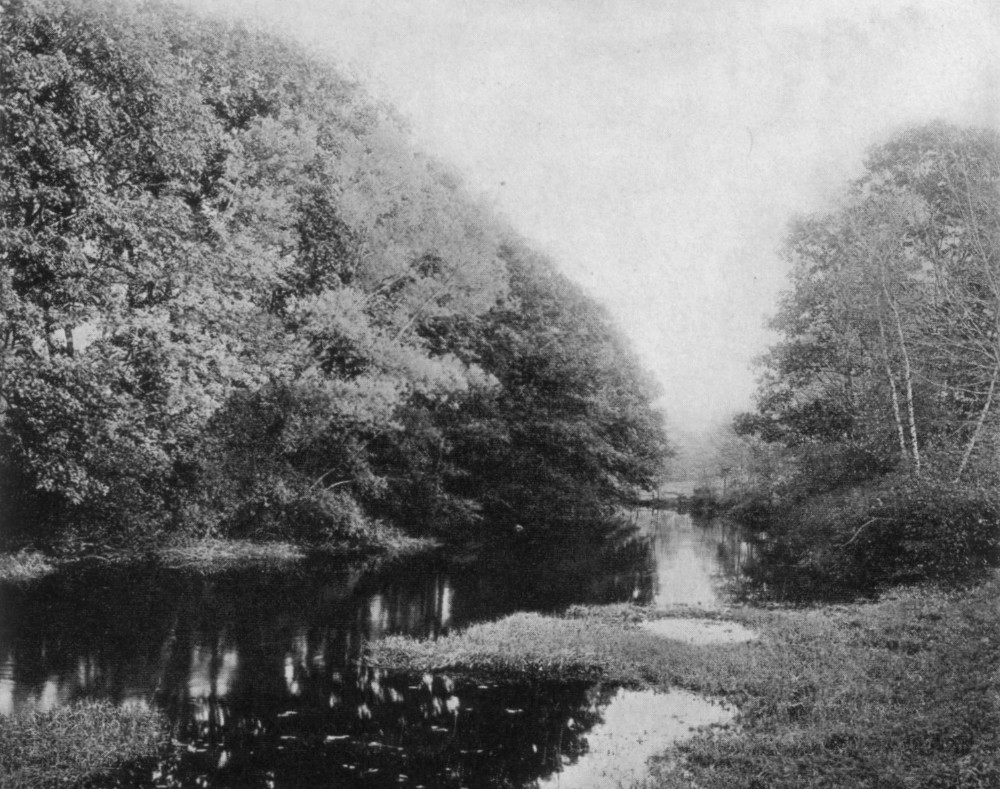 BELOW THE DAM - FRAMINGHAM 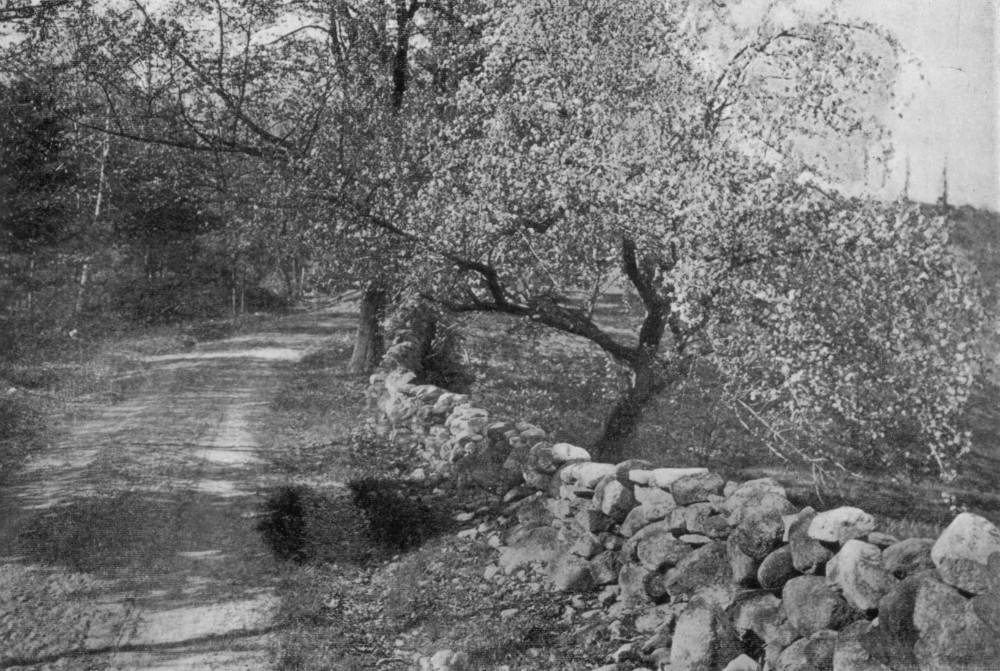 HONEYMOON STROLL - WESTMINSTER 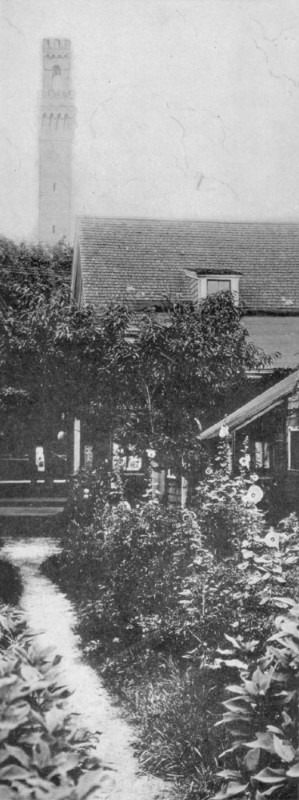  PROVINCETOWN NAN OF NANTUCKET IN AND
ABOUT PLYMOUTH THERE is no
spot on earth more significant in human history than Plymouth. There is less to
speak of the past here in the way of adequate recognition in worthy monuments
than one would hope for. As a child the writer wandered through a stone-cutting
yard on a Maine river and looked up to a huge stone forearm which loomed high
above him. Many years after he saw the massive granite monument at Plymouth of
a female figure, we can scarcely say feminine, where that same hand points
upward. It is the colossal misfortune of America that she desires monuments but
largely lacks the artistic genius. Had the execution of the Plymouth monument
been equal to its conception the result would have given us a proud shrine for
the peoples of the broad nation to visit. Yet the motive was good. That
generation tried. It had the ideal but it could not embody it in stone. The
monument stands for love and faith and truth, indeed, but the expression of
these qualities is somewhat short of what it should be. The
Standish monument at Duxbury is a graceful shaft, but Miles was far away from
us on the summit and the lightning recently cast him down. If we catch the
meaning of his character at all, he was a man never up in the air but had both
feet firmly on the ground. We have to
think of Duxbury and Kingston and the adjacent regions as Plymouth for once
they were so. They belonged to the colony as an historical and spiritual
entity. We have,
indeed, in Plymouth a very satisfactory statue of Massasoit, evidently a man of
much native nobility whose fine physique and character have been cunningly
apprehended by the sculptor. At Pilgrim
Hall, now made a permanent structure, there are certain priceless memorials of
the Pilgrim days, but there is nowhere in Plymouth nor, for that matter, in
America, a worthy house of the Seventeenth Century restored and furnished as
the second Pilgrim generation would have had it. No museum has a full
representation of the household economy of the Pilgrims. Such an assemblage was
very easy to secure ten years ago and is not wholly out of the question at
present. But there has not been in any one man or corporation at once the
knowledge, the zeal and the resources to attain this very highly desirable
accomplishment. Further, the real American, aware of the general lines of the
Mayflower, must have blushed at the nondescript affair which came into the
harbor of Plymouth during the great recent celebration. We know the contour of
the Mayflower and we know its dimensions and it is entirely feasible to
re-construct such a vessel of old timbers and place it in a ship house. Such a
work, set near a dwelling in which all parts should be strictly accurate
historically, would be more interesting, more educational and a finer work of patriotism
than anything ever done in America along these lines. As this is written a
photograph comes to hand of an apparently correct Mayflower just constructed in
California by descendants of her passengers. The persons
appointed by the national government to pass on improvements in Plymouth were
not specially fitted either by taste or education for their duties. Their
sojourn in Plymouth was very brief. The state of New York has spent great sums
in the purchase and reclamation of Seventeenth Century houses, but the state of
Massachusetts which has greater reason for doing that thing has never done so. We may
rejoice that the water front of Plymouth was very satisfactorily improved and
that the Rock has been placed under a dignified canopy. The bold bluff above
it, however, should be in the possession of a patriotic corporation or of the
nation itself. There are
one or two dwellings in Plymouth which have in them material from Seventeenth
Century structures or possibly were erected themselves in the latter part of
that period, but for the most part the growth of the town has obliterated such
ancient landmarks. The most dignified and worthy and interesting feature of
Plymouth at present is Pilgrim Hall and its contents. Here one may go
repeatedly with delight and profit. Referring to what we have said elsewhere
regarding Cape Cod wrecks, the ancient skeleton of a vessel, exhumed from the
Cape Cod sands, now in the basement of Pilgrim Hall, fills one with a sense of
our nearness to that period, and with astonishment at the small, size of the
craft that dared the Atlantic and sometimes, as in this case, dared fatally. The gardens
of Plymouth, bits of which we show, are among its more pleasing features as we
call to mind the English custom of having a flower plot in front of every
cottage. The most striking feature about the township of Plymouth taken at large, is the great number of fresh water lakes, one being named from the black sheep of the Mayflower, "Billington Sea." These lakes are increasingly valuable as water supplies. The region south of Plymouth is a striking example of the scrub growth of oak and pine which is so common in this part of the state. We find Bradford in his history lamenting the continuous exodus from Plymouth and its slow growth after more than a generation had elapsed since the settlement. Such a condition was inevitable, since better lands called to a people engaged almost exclusively in agriculture, excepting only fisheries. 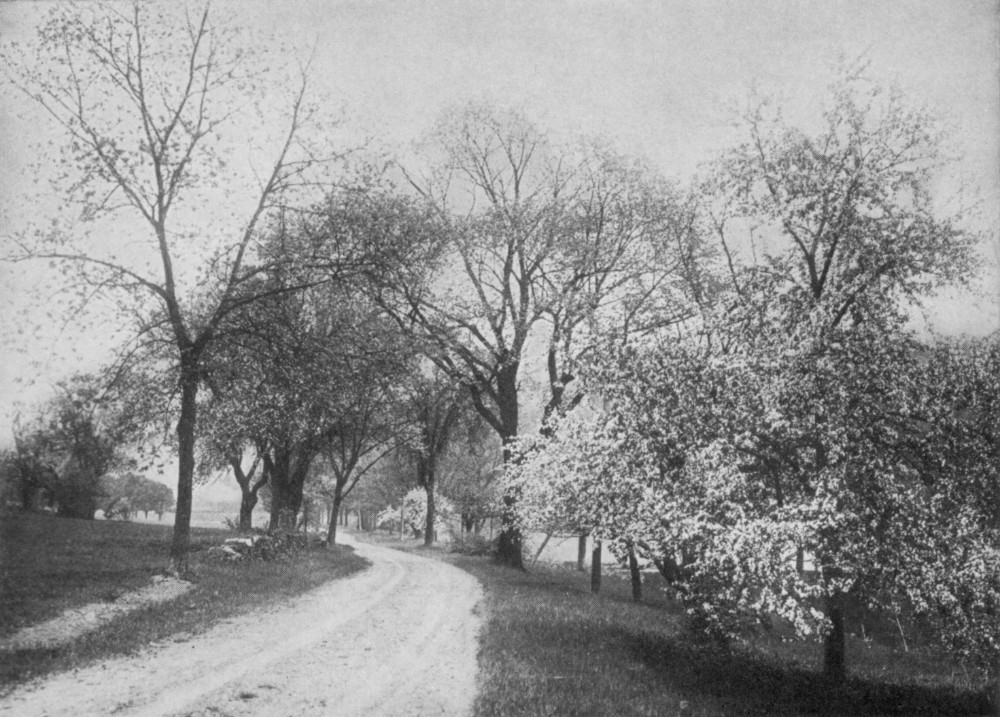 FRAGRANT WAY - MOHAWK TRAIL  THE ROAD TO UNCLE JONATHAN'S - BERKSHIRES 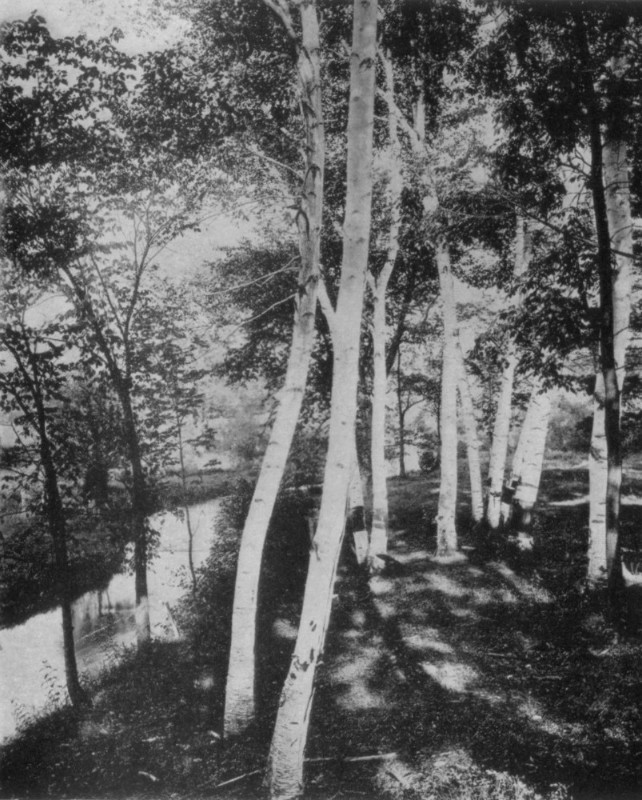 SLENDER BIRCHES - STOCKBRIDGE 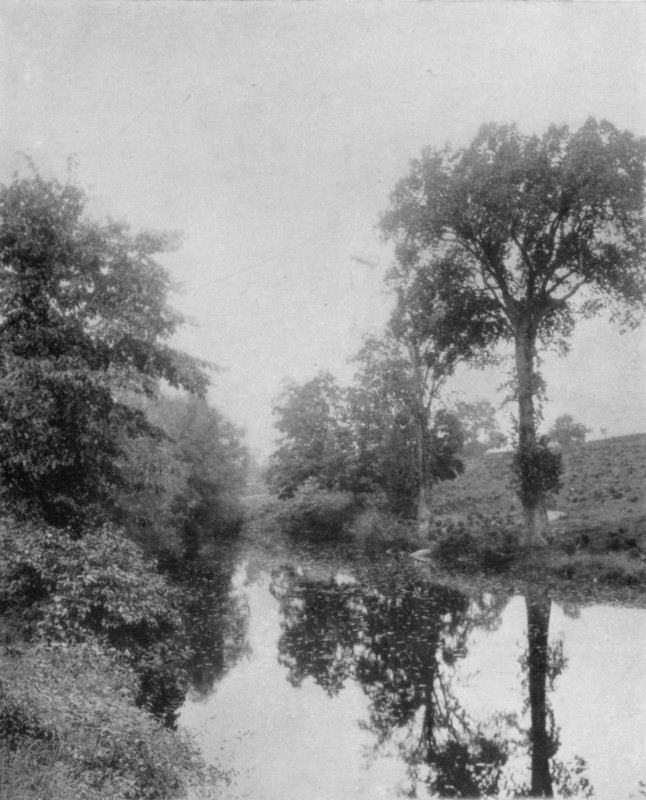 TYRINGHAM WATERS The Major
Bradford house in Kingston on the road to Duxbury at Jones River has lately
been redeemed. If one stands well back from it on the front it affords a very
good example of the second period of Colonial houses. It may be hoped that in
the process of time greater knowledge and resources may endow some of these
early houses with valuable contents matching their period. It is
markedly true not only of Plymouth but of most other Massachusetts towns which
have grown beyond the small village stage that they have lost most of their
simple and quiet architecture. No doubt this is inevitable. It is not set down
here as an adverse criticism but only to call attention to the fact that if we
would see a village as it was a hundred or a hundred and fifty years ago we
must go to one which has not developed into a mart or into a manufacturing
center. In this particular, Kingston, Duxbury, and Marshfield have an advantage
over other towns more nationally known. They retain many of the early edifices,
and although the Seventeenth Century house is uncommon, something more than one
hundred such houses have been tallied, and perhaps two or three hundred between
York, Maine, and New York City and up the main rivers of most ancient
settlement. The
occupants of early houses are themselves frequently lacking a special study of
early architecture and as a consequence, having lost the authentic records of
changes made in their dwellings, if any such records existed, these residents
are not seldom mistaken as to the date of their dwellings, but they are more
frequently mistaken as to the date of the present appearance of these
dwellings. Very few of these early houses have escaped what were thought to be
improvements. The same remark may apply to furniture. We have often observed
owners far more taken up with furniture of their Aunt Sarah than with that
which preceded it by two or three generations and was ten times as important
from the historical and constructional point of view. It is practically
impossible to find a house of harmonious style throughout, still less such a
house with interior decorations also in keeping with its time. The first
range of towns inland from Plymouth was also on an inferior soil, and it is not
until we get into the vicinity of Taunton and towns of about that distance from
the shore that we see marks of general and successful cultivation of profitable
fields. The two
main routes from Boston to Plymouth are both most interesting and quite
different. Some of the villages like Cohasset, Scituate and Hingham possess
numerous fascinating old dwellings and one can consume weeks in a thoroughly
satisfactory meandering over the main and cross roads of this entire section. |